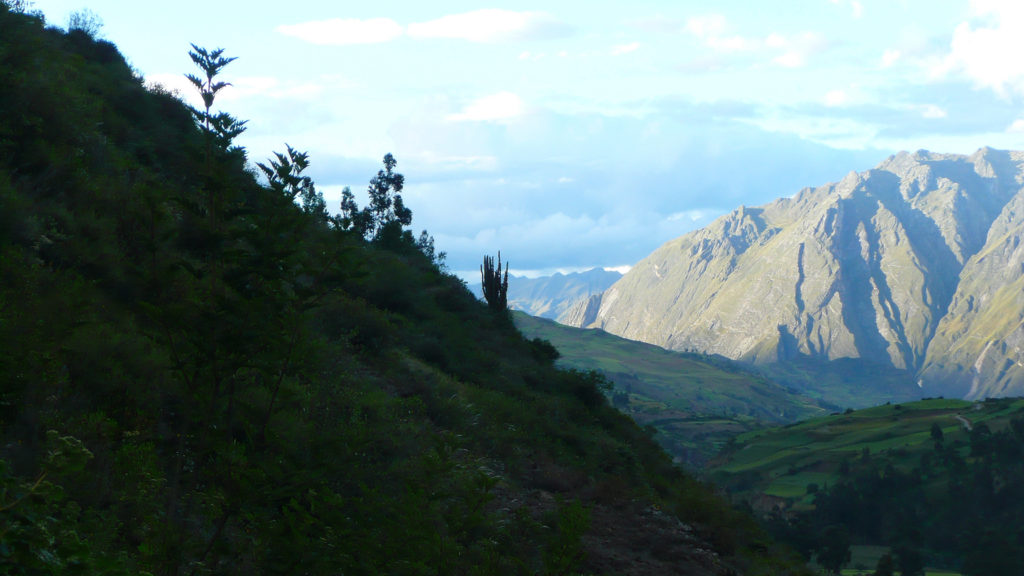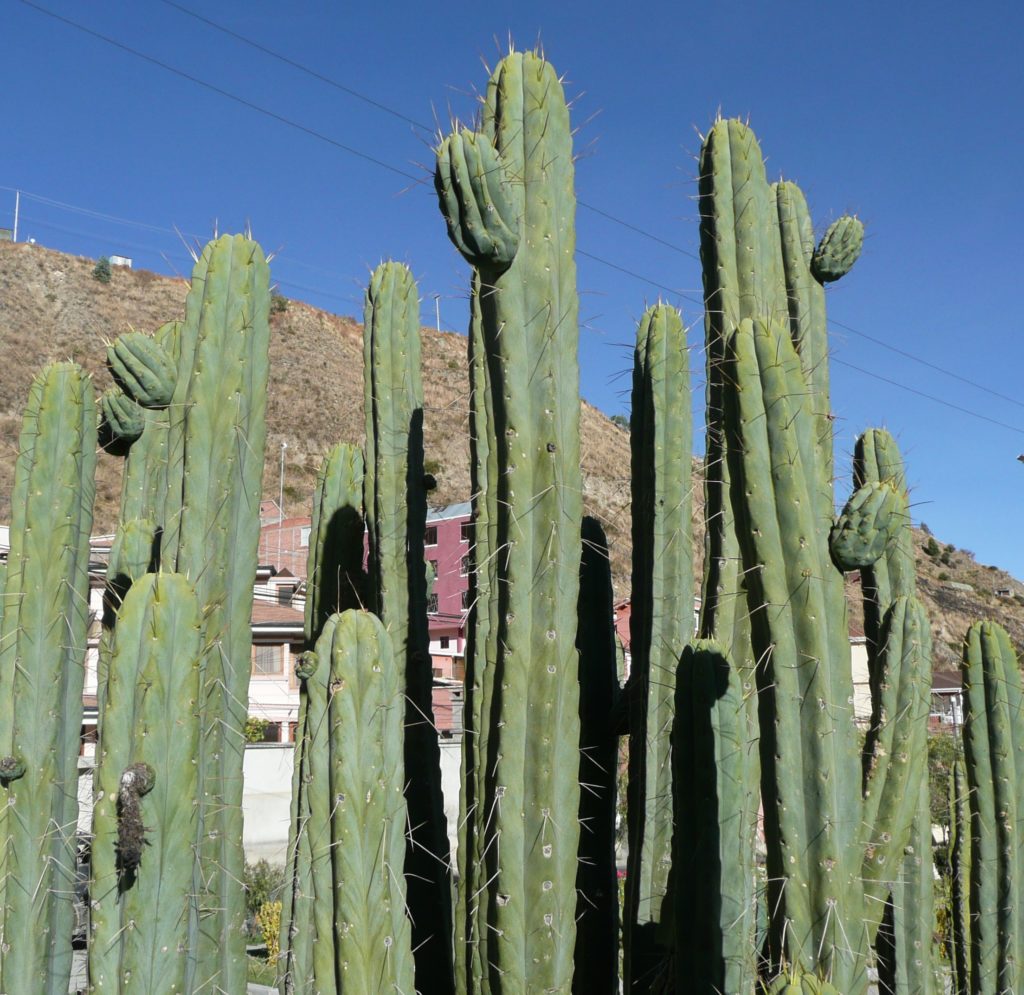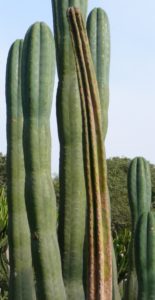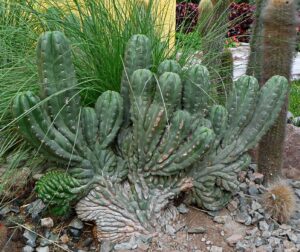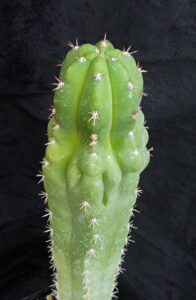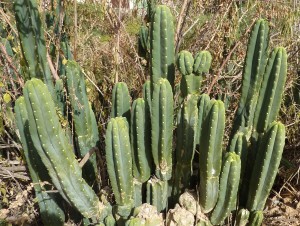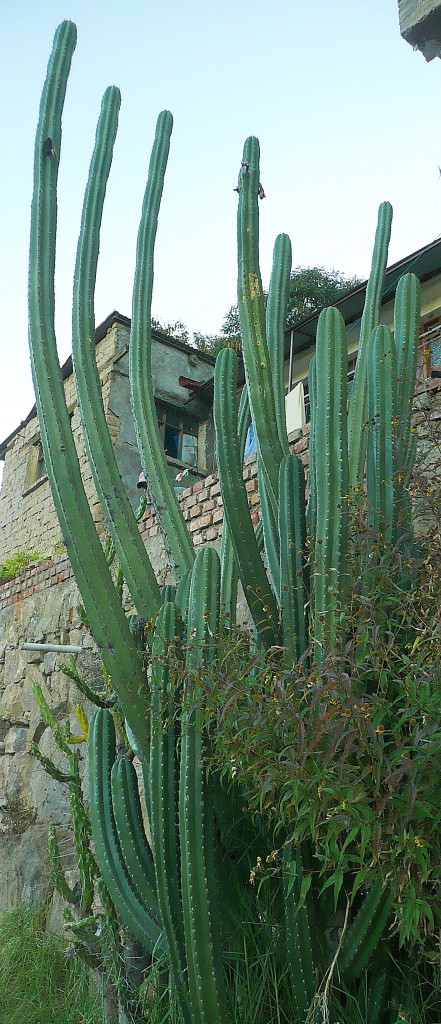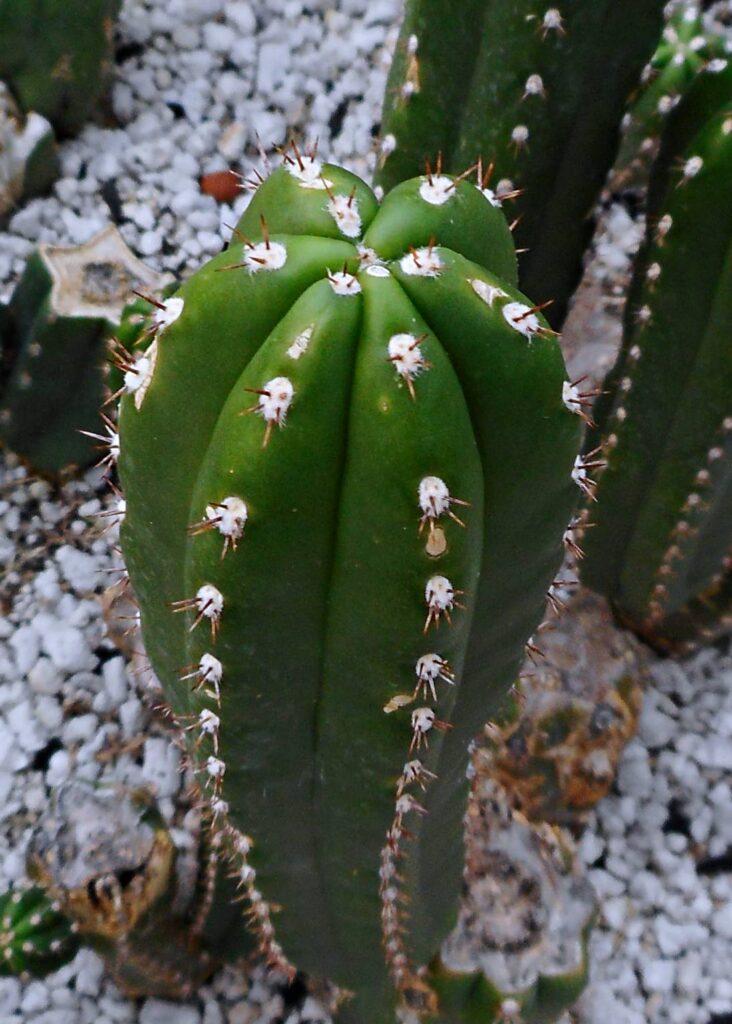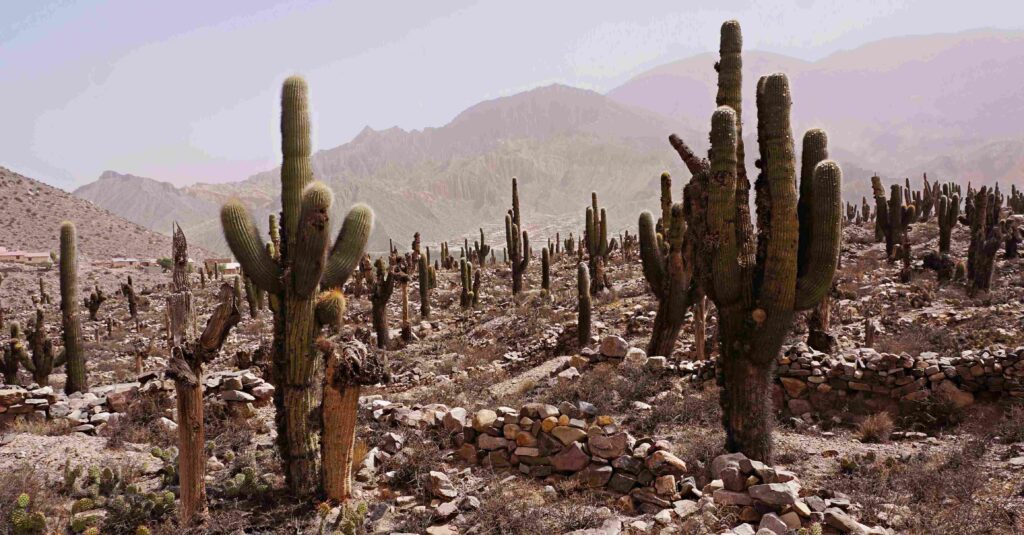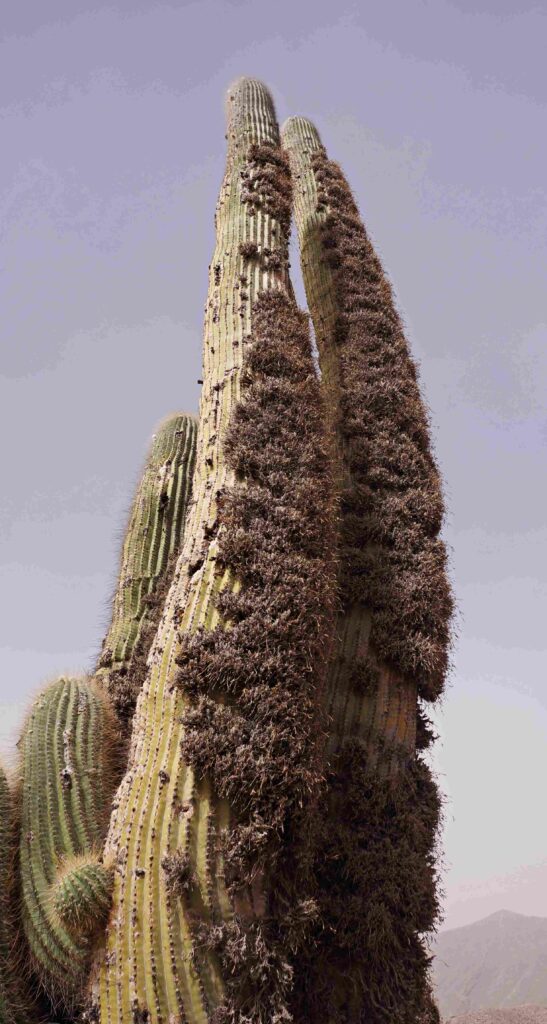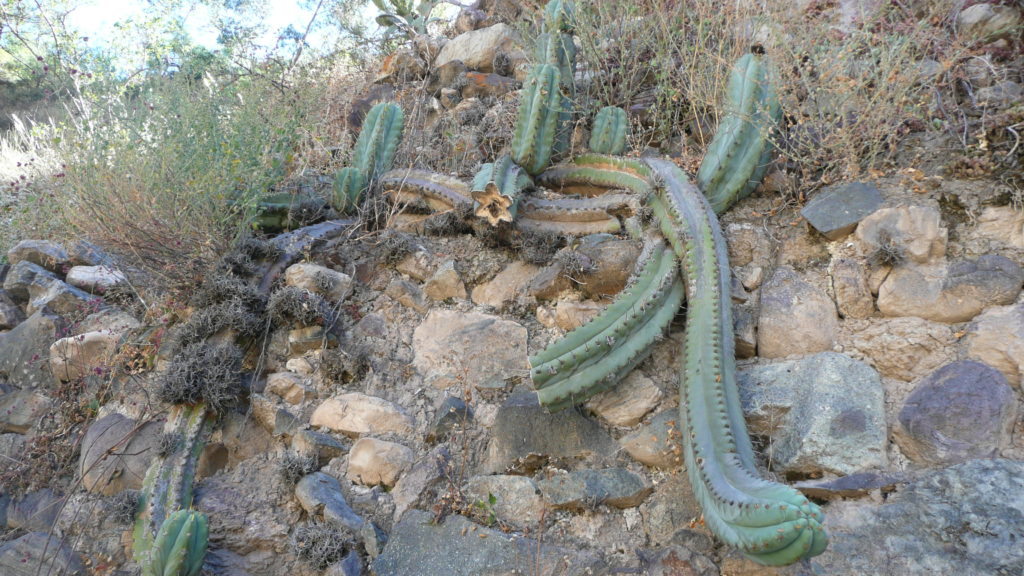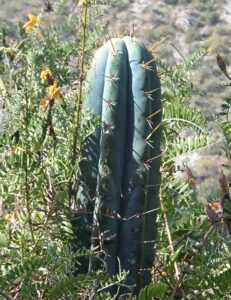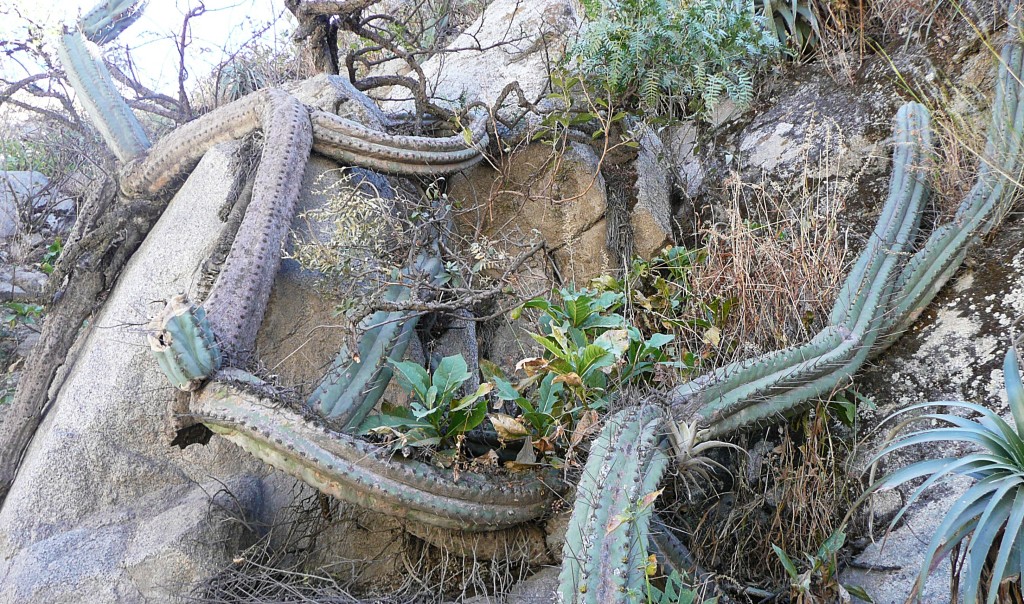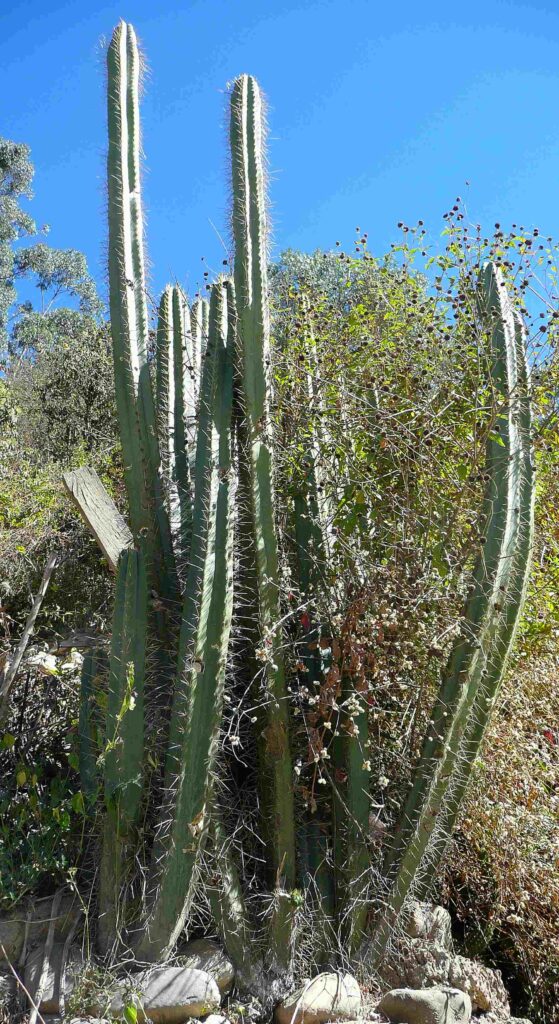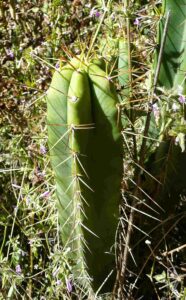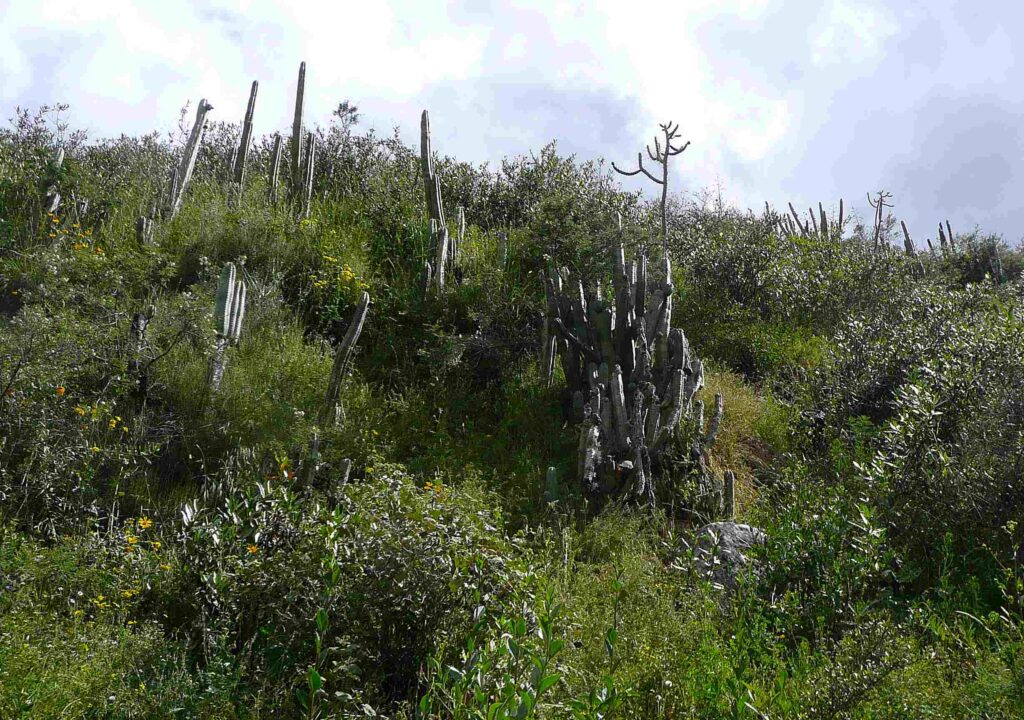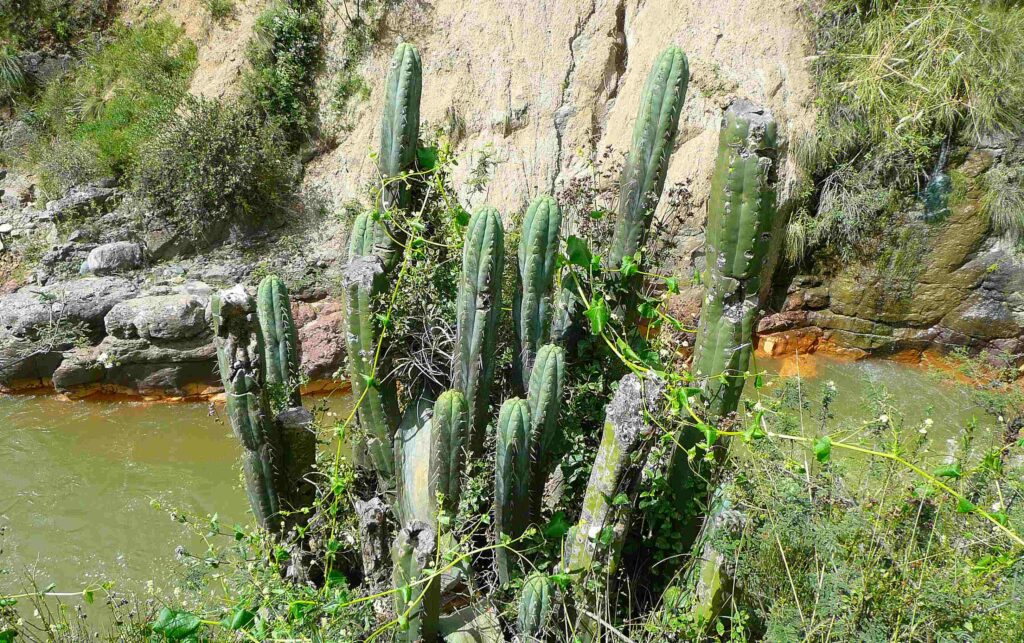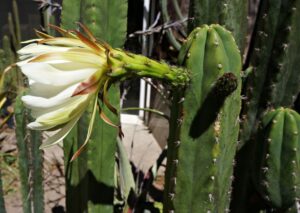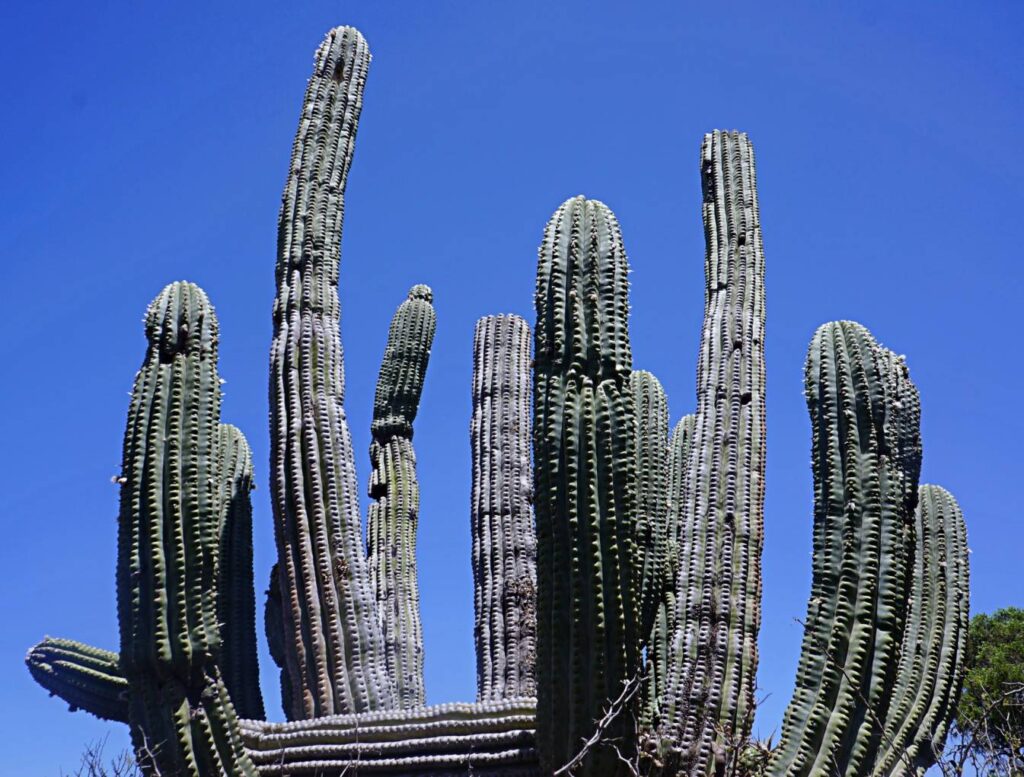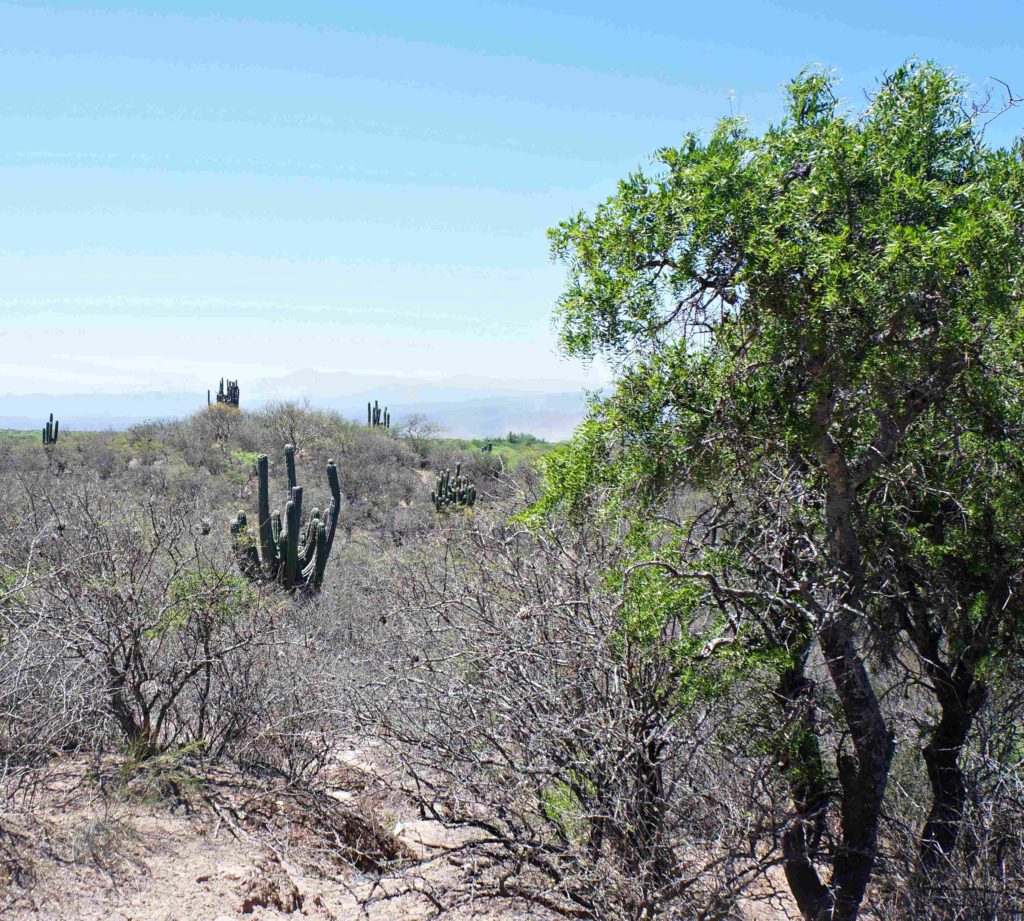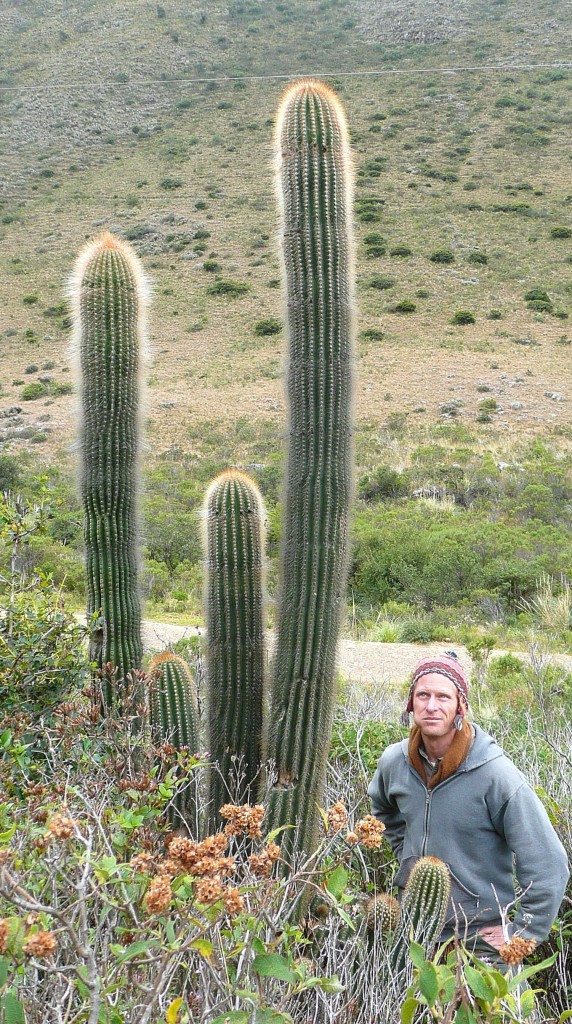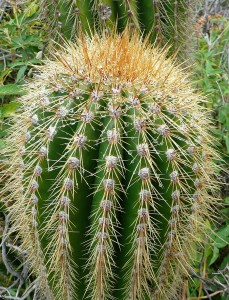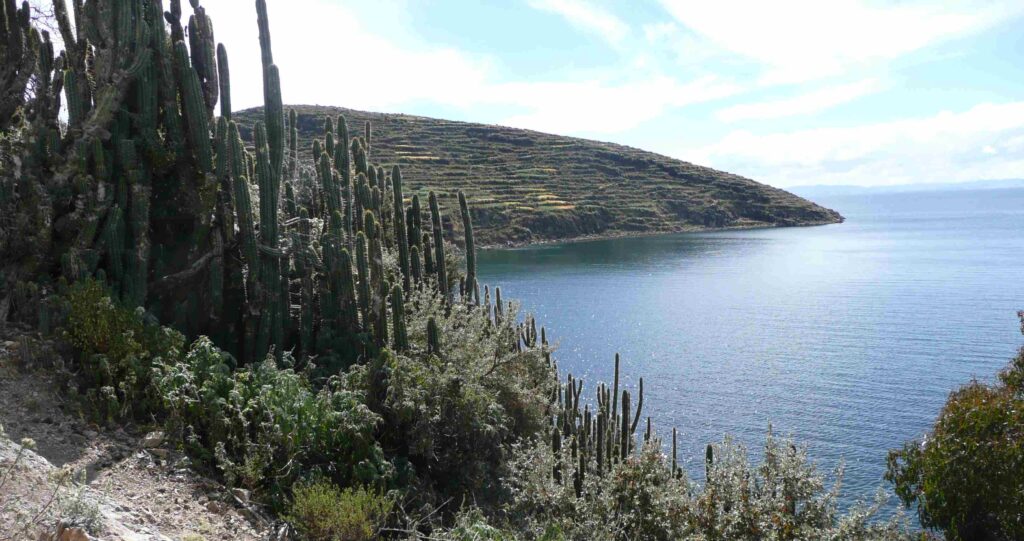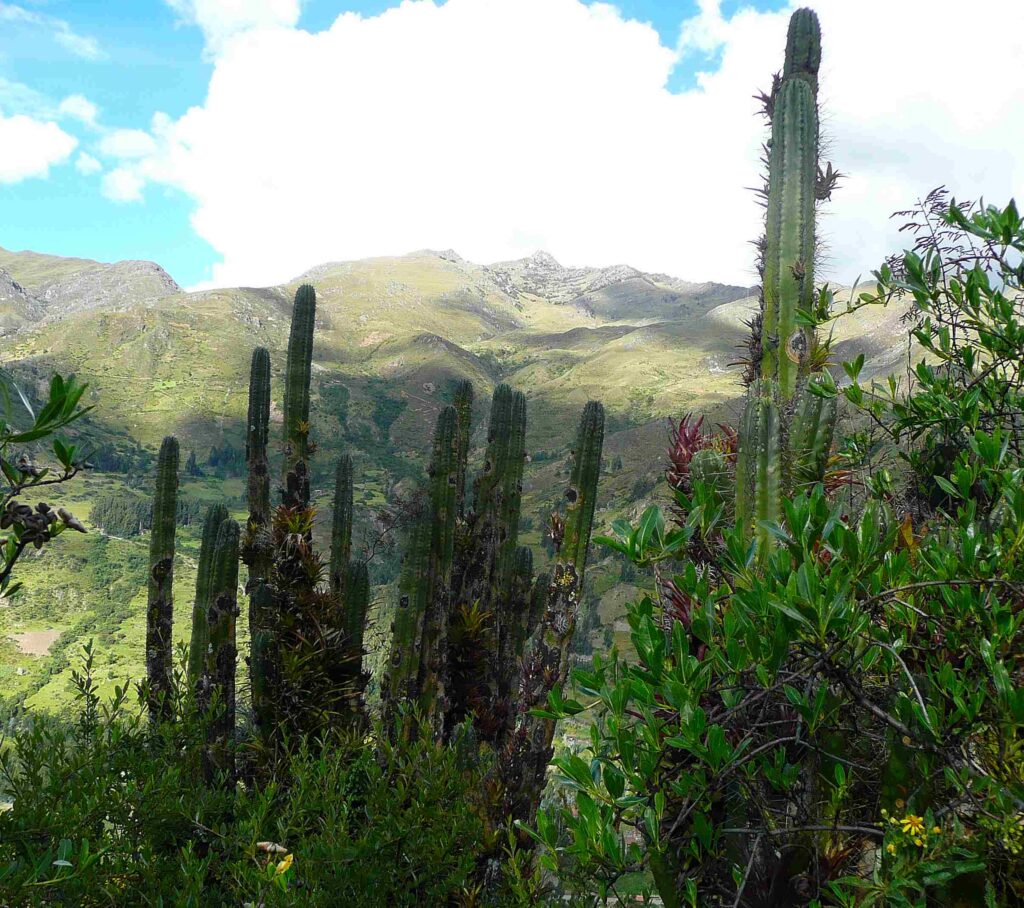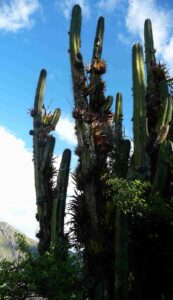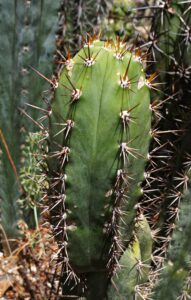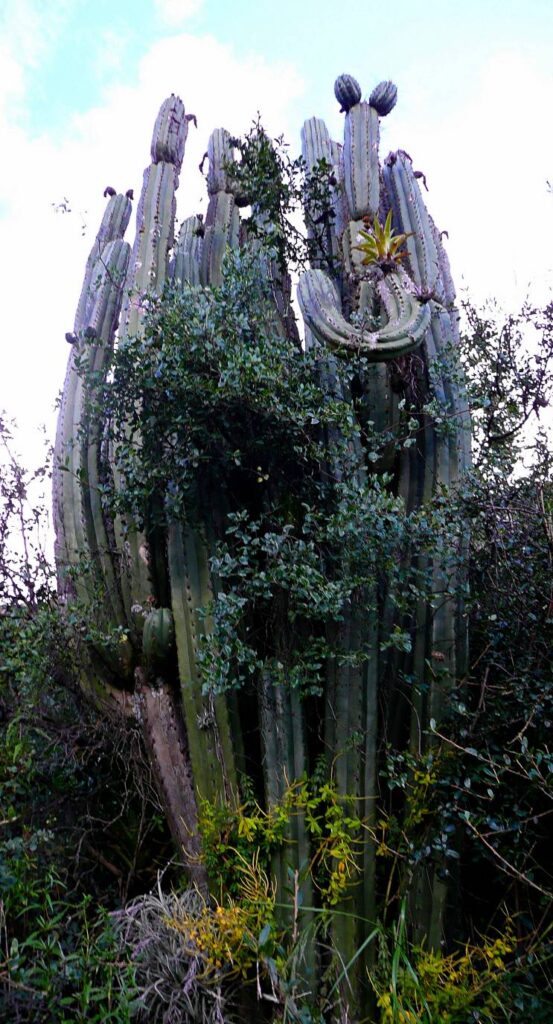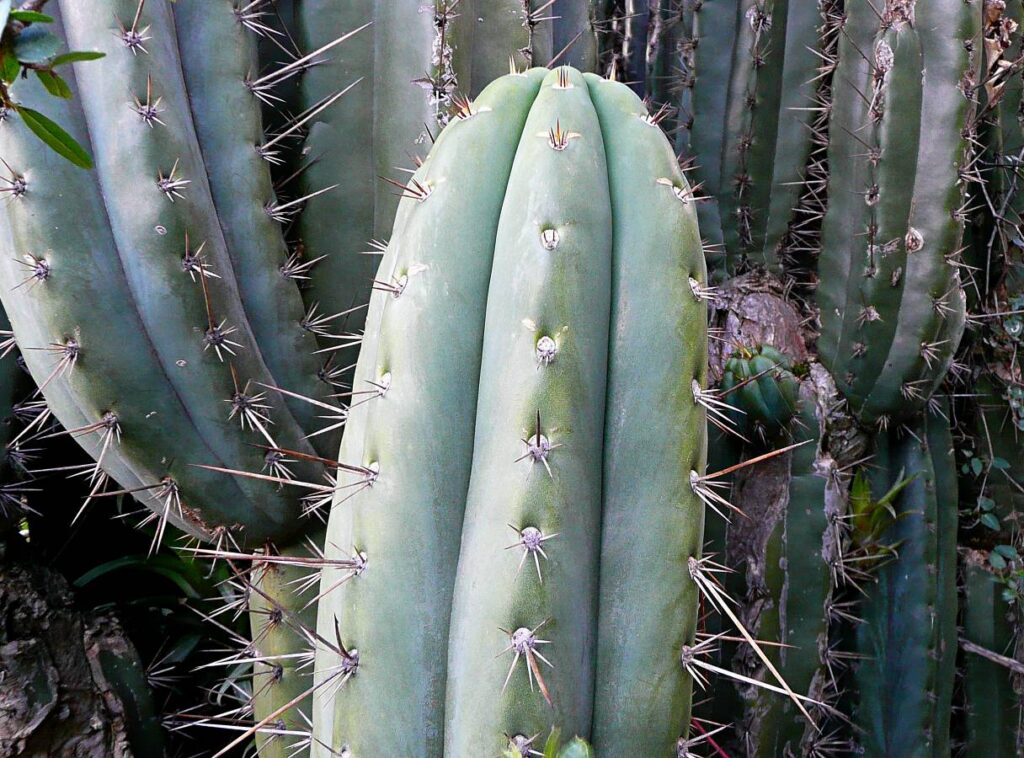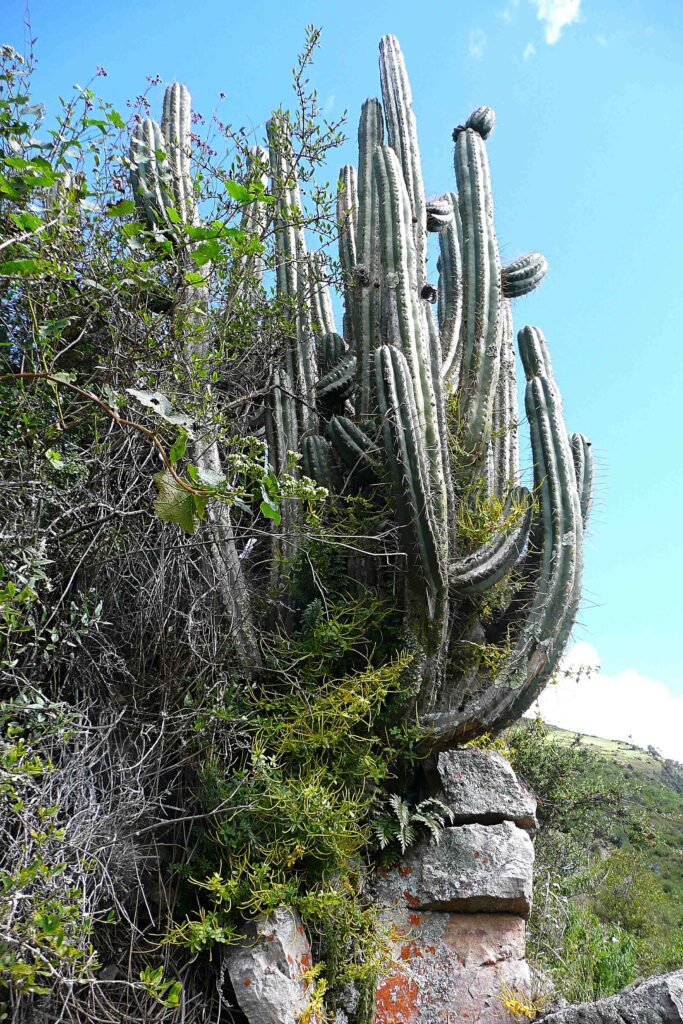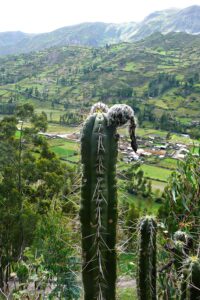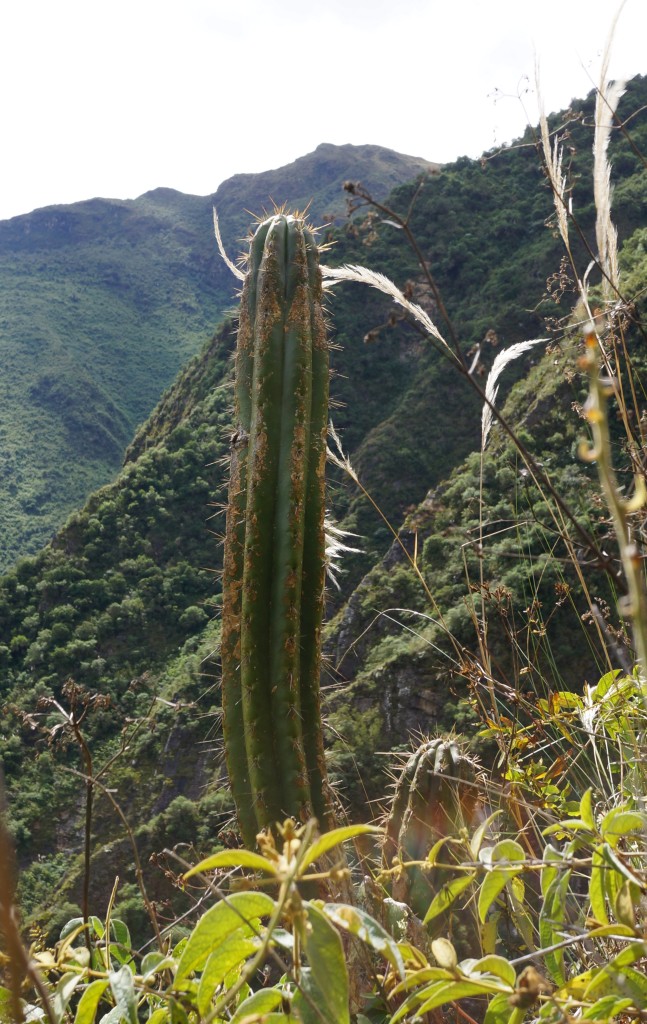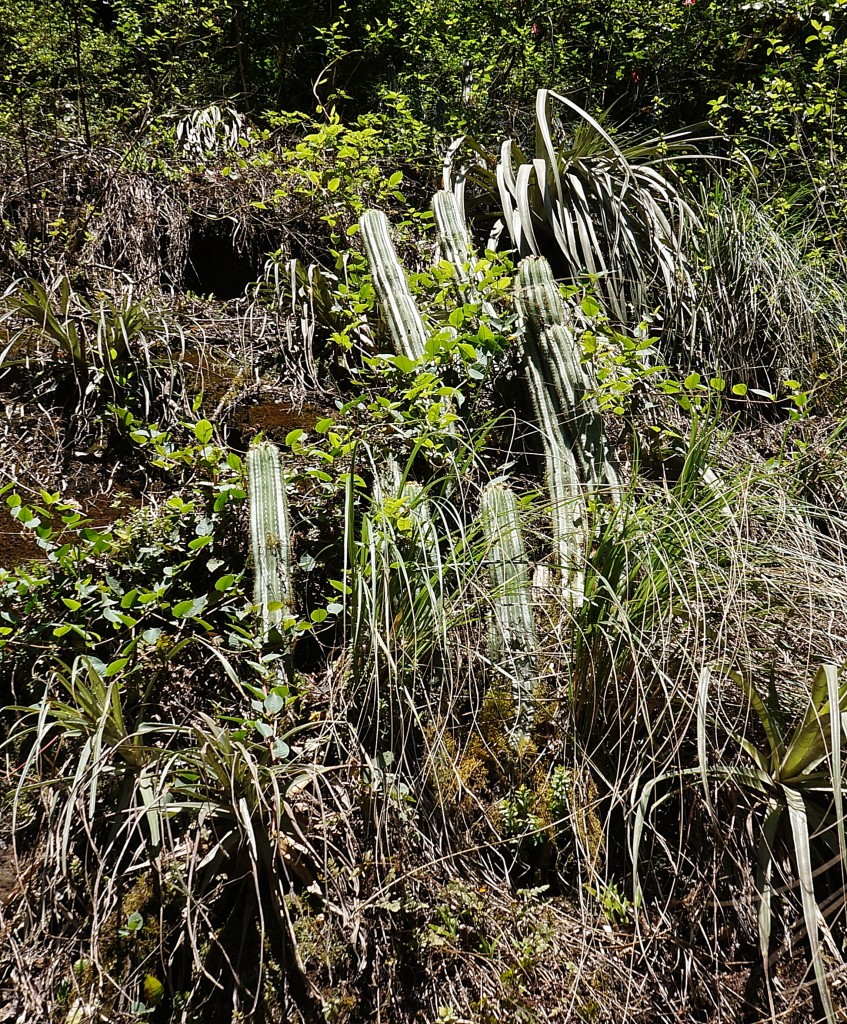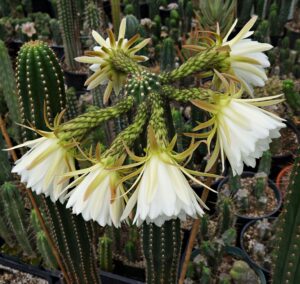Information on Distributed Trichocereus BK Field Accessions
For over two decades we have been involved in a long term interdisciplinary field study of the ethnobotany, ecology, distribution and taxonomy of Trichocereus cacti. We’re aware there is some confusion out there around our Trichocereus BK accessions distributed over the years. For clarity, we recently began work on a document that catalogs all 40+ of these field accessions together in one place. While fleshing out the descriptions more thoroughly, we’re incorporating greater detail about the Andean habitat of each collection, including companion plants associates, plus additional ethnobotany and regional history. We also recognize the value in sharing information about distribution — what year we originally introduced an accession into cultivation, what it was (seed, cuttings, seedlings), what has been distributed over the ensuing years, and approximate quantities. We had naively thought we could pull this together into a new web page, featuring photos of the plants, both in-situ and ex-situ, by winter solstice… Well, it turns out that this is a much larger undertaking than we’d anticipated! In our scant ‘spare’ time, we’ve been looking over thousands of photos, reading through our old field notes, two decades of Sacred Succulents catalogs, and hundreds of pages of SS supplements, rare plant lists, etc., not to mention additional reference material. We now endeavor to work on this in stages, updating the webpage periodically, with the goal to have the entire project completed summer 2025.
We hope to have more of the Trichocereus BK descriptions and images posted in the coming weeks!
◊
Coming soon! —
A full descriptive & photographic account of our Trichocereus BK accessions that we have distributed.
◊
This page is informational, for Trichocereus available to order, see our Specimen Plant List
◊
Key to BK accessions:
Example: Trichocereus cuzcoensis BK08526.4 (=T. peruvianus v. cuzcoensis) “Hawaq’ollay” “San Pedro Agreste”
= Genus, species, Accession#[see breakdown below↓], (= synonym), “local names” and/or “common names”
BK = Ben Kamm; the next two #s designate the year the accession was made [08 = 2008]; the next # is the month [5 = May]; the next two #s are the day of the month [26 = the 26th]; finally, the # after the period is the sequence within the collections we made that day [.4 = the fourth plant accession that day].
◊
List of Trichocereus accessions collected & distributed by Ben Kamm (BK)
4/21/25
Page under construction—more info and photos coming!
◊
Trichocereus bridgesii BK08603.3 “Achuma” “Bolivian San Pedro”
Large stands to 12’+, 3–3.5″+ diameter blue-green stems, 2–3″ long spines. Classic T. bridgesii, growing with Prosopis aff. alba, Ephedra americana, Puya sp., Corryocactus melanotrichus, Oreocereus pseudofossulatus, Echinopsis bridgesii, Carica quercifolia, Opuntia teres, Dodonaea viscosa, etc., Hacienda Huajchilla, Murillo Province, south-east of La Paz City, over 10,000′, Bolivia. Remnant dry forest/semi-arid thorn scrub in the broad valley carved out by the Rio La Paz. We were told that this was once among the favored spots for local herbalists to harvest Achuma for the famous Mercado de las Brujas & La Hechiceria (Witches’ Market) of La Paz City, but when we arrived the whole area was under development as a wealthy suburb. These specific T. bridgesii populations are undoubtedly gone as they were threatened by impending golf and tennis courts when we collected this seed in 2008… The populations on the surrounding mountain slopes, which include some interesting monstrose plants, have hopefully remained untouched. Z9a
- What has been distributed: Seed—several thousand between 2008–11; several dozen seedlings between 2011–14; cuttings from several seed grown plants have occasionally been offered since 2015, though rarely in recent years.
__
Trichocereus bridgesii BK08608.2 “Achuma” “Bolivian San Pedro”
Thick stand of plants with somewhat freakish monstrose growth, especially at the tips where the tissue was very convoluted. The rather abominable mutant growth looked like it was due to a mealy-bug pest seen in the fissures of the plant. These unforgettable T. bridgesii were growing just beyond the edge of the suburbs, in the mountains north-east of La Paz City, La Paz, Bolivia, above 12,000′. Occurring with Tillandsia, Austrocylindropuntia, Baccharis, and Dunalia species, etc. Our friend and artist Efrain Ortuno was excited to show us this uncanny, “potent” population of ‘mutant’ plants in 2008. He informed us that these grotesque specimens were specially regarded by local curanderos and that there were plants among this population that sometimes produced red flowers… and he showed us his painting to “prove” it! Our surviving plant has yet to bloom, so we can’t confirm flower color. We collected a few seed and 1 cutting (quarantined & thoroughly cleaned of pests). We planted all of the scant seed only to lose the seedlings the first year to rodents—none had shown true monstrose growth prior to the mouse’s banquet. After the sterilization of the mealy-bugs and quarantine, the cutting returned to normal and has not expressed mutant growth since. None-the-less, this remains a beautiful and coveted accession among collectors… those who dream that some memory of bizarre, convoluted growth lies dormant within the plant’s tissue, ready to reassert itself (sans mealies!) under the right conditions to our awe and appalled delight! Z9a
- What has been distributed: Cuttings of 1 clone. We’ve only offered cuttings of this clone a handful of times between 2016 and the present, though very rarely in recent years.

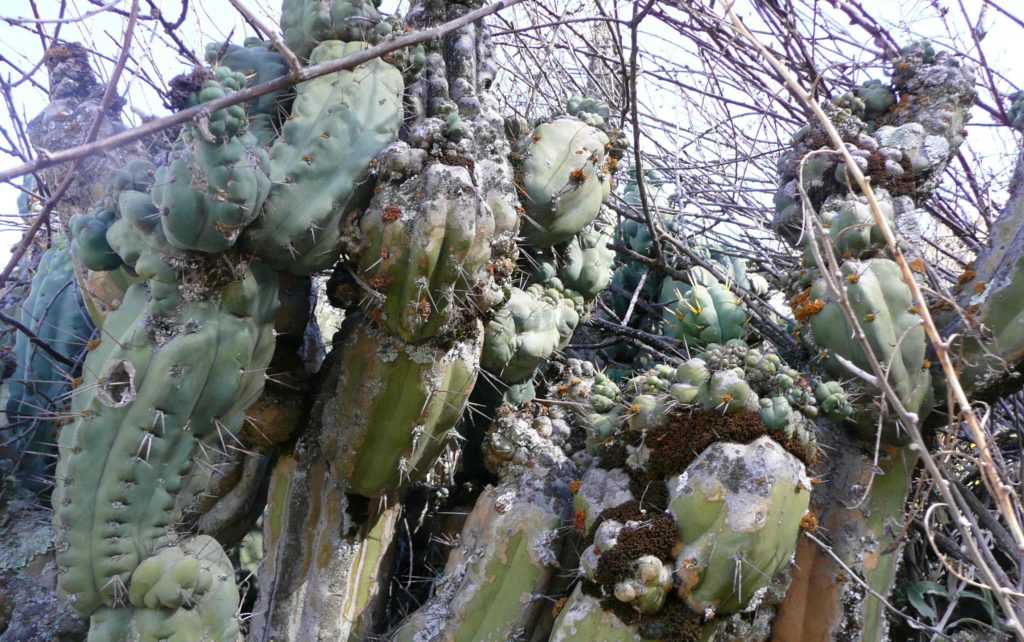 ↑ BK08608.2 ↑
↑ BK08608.2 ↑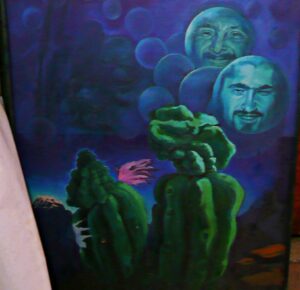 ↑ Efrain Ortuno’s painting of red flowered BK08608.2 ↑
↑ Efrain Ortuno’s painting of red flowered BK08608.2 ↑
__
Trichocereus bridgesii BK08608.3 “Achuma” “Bolivian San Pedro”
Seed from broad stands to 12′ + tall, 3.5–4″+ diameter blue-green stems, spined to nearly spineless—very similar to SS02 in appearance. These were a ‘normal’ form growing among bizarre, monstrose plants (BK08608.2) that appeared mutated due to a mealy-bug infestation. These remnant populations were observed in 2008, growing with with Tillandsia, Austrocylindropuntia, Baccharis, and Dunalia species, as well as introduced Cupressus and Sparteum junceum, on the edge of the suburbs, in the mountains north-east of La Paz City, La Paz, Bolivia, at well over 12,000′. May now be lost to development—at the time there were signs people had not only been harvesting the cactus for El Mercado de las Brujas, but had been removing it entirely from the hillsides—there were large heaps where the cactus had been cut and discarded with trash. We were informed by our artist friend, Efrain Ortuno, that this locale had long been known among local Aymara herbalists and it was here that a highly “potent” population of “rose-red flowered Achuma” occurred! None of our plants have bloomed yet, so we can neither dismiss or confirm his assertion; for now, we can only daydream that such a unique trait would show up in our seed grown offspring. So far, the progeny are a bit spinier than the ‘wild’ parents and have not yet expressed any mutations. This accession is little known in cultivation, one of several unique San Pedro we’ve largely kept for our own studies. Certainly a “must have” for the serious collector, it’s been some years since we offered this mysterious, endangered accession at all. Z9a
- What has been distributed: Seed—several hundred in 2008; around a dozen seedlings between 2011–16; less than a dozen cuttings total, from several seed grown plants, have been offered since 2016.
- Clone A: one of our seed grown plants, selected for its attractive spination and hardiness—the mother has endured full exposure through many harsh seasons unscathed. Our distribution of this clone has been minimal.
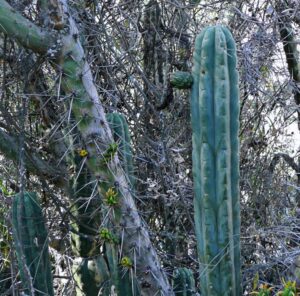
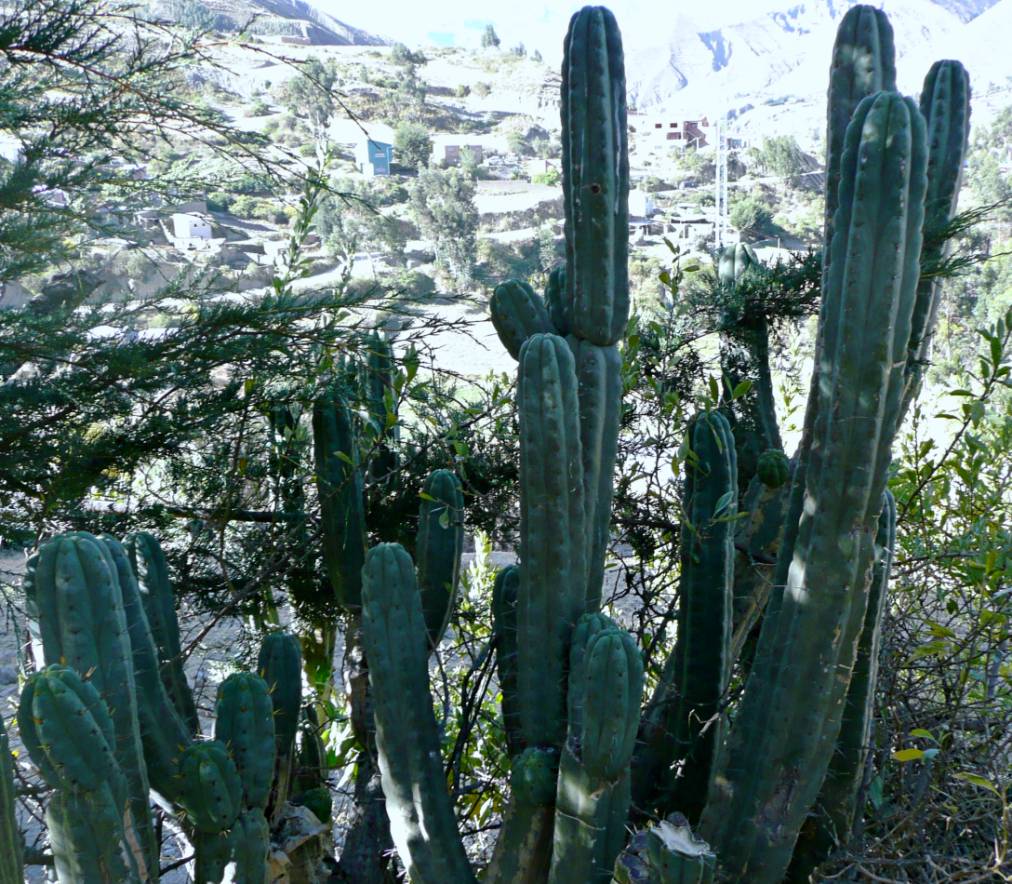
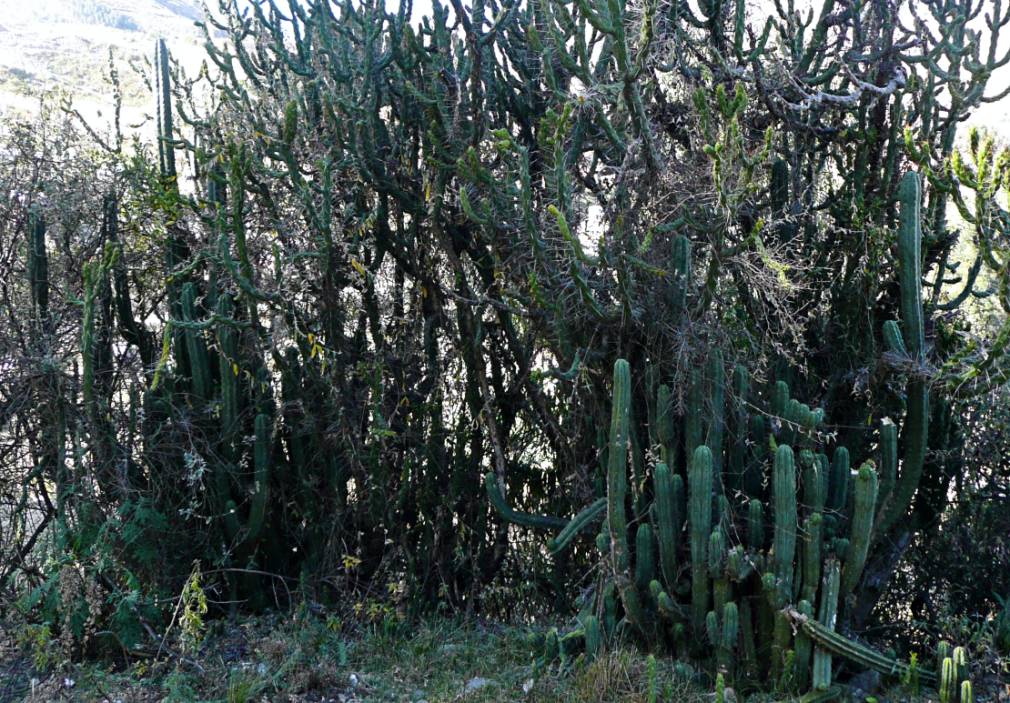
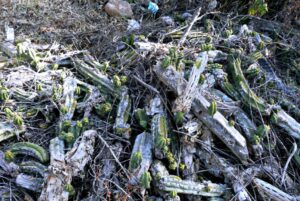 ↑ BK08608.3 ↑
↑ BK08608.3 ↑ ↑ BK08608.3 clone A ↑
↑ BK08608.3 clone A ↑
__
Trichocereus bridgesii BK08608.4 “Achuma” “Bolivian San Pedro”
Healthy and super robust stands of blue-green columns to 10′ + tall. 3–4″ thick stems, long spines, large white flowers and fruit. Growing at Parque El Vergel, east La Paz City, above the Rio Irpavi, 11,500′, Bolivia. This area is now one of the more affluent neighborhoods of La Paz, yet we were told this region was once biodiverse dry-forest, thick with tall, dense “walls” of T. bridgesii (a close-by zone is named Achumani) before the Bolivian military’s Achuma eradication program in the 1970s, and later urban development for the bourgeoisie, razed the unique ecosystem and reduced the cactus to a denizen of parks and steep hillsides. This seed accession came from some of the nicest plants we saw around the La Paz basin—the bluest and most uniformly fat stems. Rarely offered, but has become a high valued accession among collectors. In addition to the well known ceremonial uses, T. bridgesii is an ingredient in traditional misa offerings, the sap is said to be good for rabies, the flowers are a diuretic, the sweet fruit relished by children, and the stem flesh used for wound healing, mumps, and cancer. Z9a
- What has been distributed: Seed—around a thousand in 2008; a couple dozen seedlings between 2011–13, cuttings from several seed grown plants have occasionally been offered since 2014, though rarely in recent years.
__
Trichocereus cuzcoensis BK02 (=T. peruvianus v. cuzcoensis) “Hawaq’ollay” “San Pedro Agreste”
The second official plant accession we ever recorded [& prior to our current accession # methods], during our second trip to Peru, at the age of 21 in 1996. A huge stand of dozens of upright and sprawling stems to over 15′ tall and more than 20′ in diameter, one of the biggest single plants we’ve ever seen of this species! Olive-green to blue blushed skin, numerous spines from 1 to 3.5″ long, emerging golden with the new growth and fading gray with age. White flowers, edible fruit. Many of the spiny stems were clothed in several silvery Tillandsia species, with epiphytic orchids, Peperomia and Pilea sprouting on the branches among these bromeliads! Growing among Baccharis and other shrubs in the Urubamba Valley bottom, around 9000′, not far from the river, along the Incan trail and some miles north of the Incan stronghold of Ollantaytambo (the final holdout of Incan resistance in the Sacred Valley to the Spanish invaders until 1537), Cusco Dept., Peru. This useful Trichocereus is a denizen of the interAndean valleys and eastern slopes of the Andes, from central to southern Peru. This broad distribution is likely at least partly anthropogenic, as this has been an important utilitarian and ethnomedicinal species since antiquity and is often found at archaeological sites today. We observed sections of de-spined stems being offered by Quechua vendors at the Cascaparo herbal market in Cusco City as a remedy for headaches, burns, fevers, flu, to reduce swelling from injuries, and for use as a “kind of shampoo” (or leave-in conditioner) said to treat baldness by promoting hair growth and protecting the hair from the elements while giving it a satiny sheen. In fact, we were told that the impressively long, beautiful hair of many Quechua women was due to their use of the cactus. Stem tissue was said to be “eaten in salads as a contraceptive”, though we’ve never been able to confirm details or efficacy. The sap of the cactus has a long history of use as a finish on adobe walls. Ethnobotanist Rob Montgomery later came across the flowers of this species being sold in a Cusco market for use as a heart tonic tea and for “flying”. Rarely offered, we originally distributed it as Trichocereus peruvianus v. cuzcoensis. Z8b?
- What has been distributed: Cuttings of 1 clone, offered less than a dozen times since 2009.
Making Hawaq’ollay ‘shampoo’ with T. cuzcoensis ↓
Our heartfelt gratitude to the Quespe family in Chinchero, Cusco Dept., Peru for sharing their knowledge.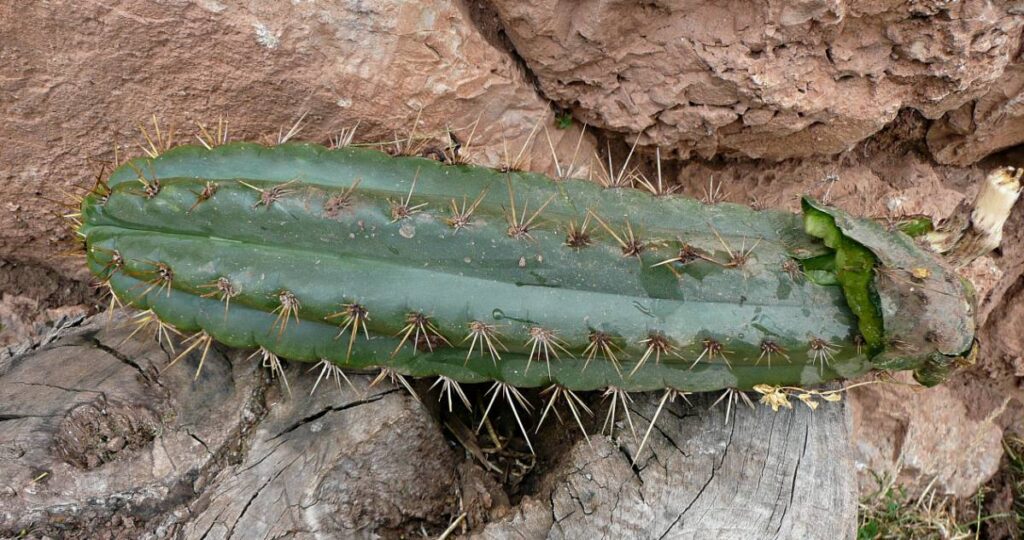
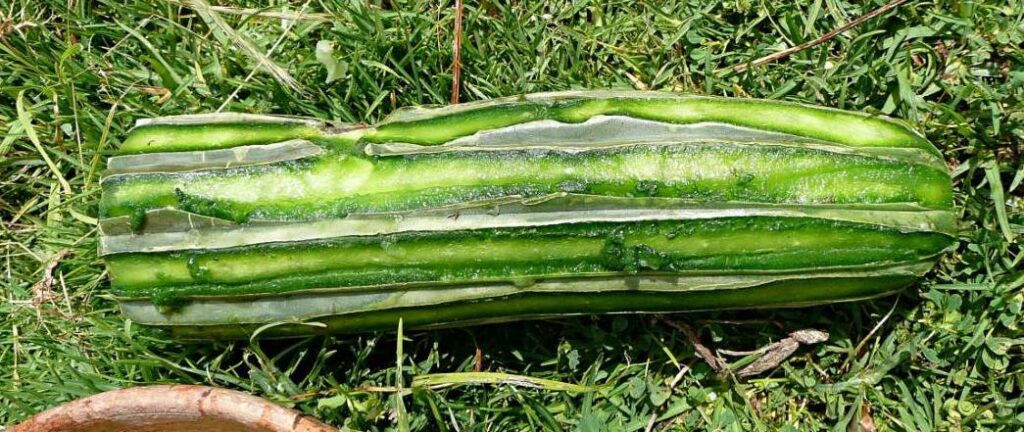 ↑ Cut and de-spined stems ↑
↑ Cut and de-spined stems ↑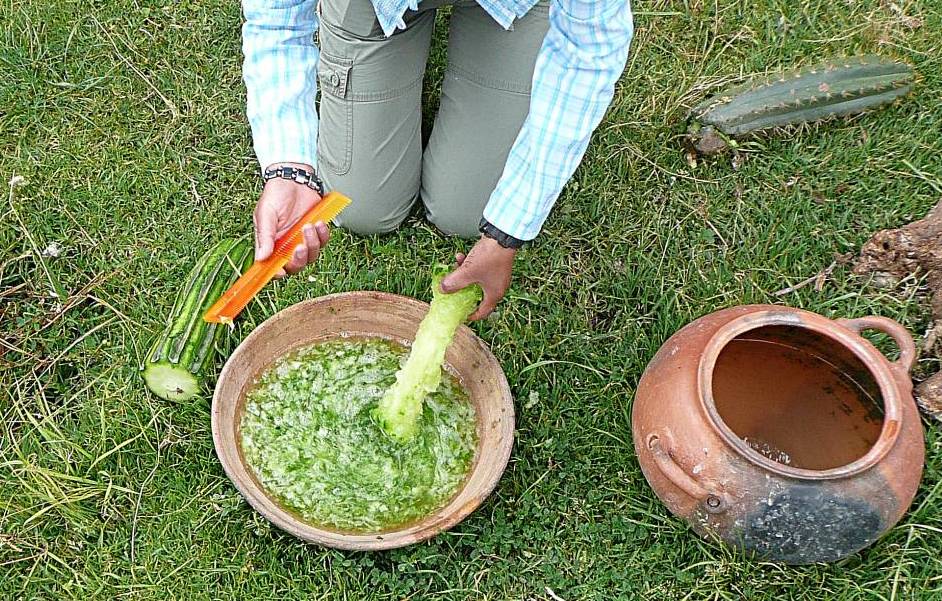
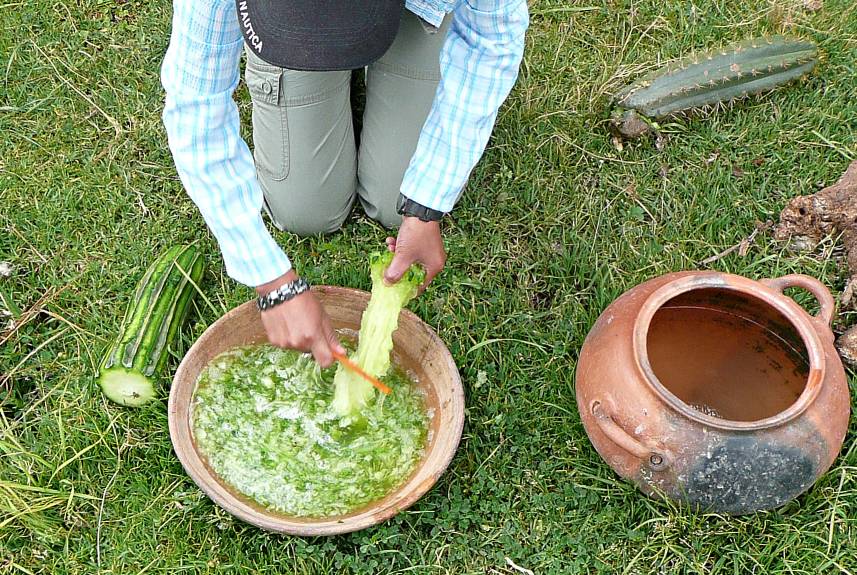 ↑ Making ‘shampoo’ by shredding the cactus with a comb in a bowel of water ↑
↑ Making ‘shampoo’ by shredding the cactus with a comb in a bowel of water ↑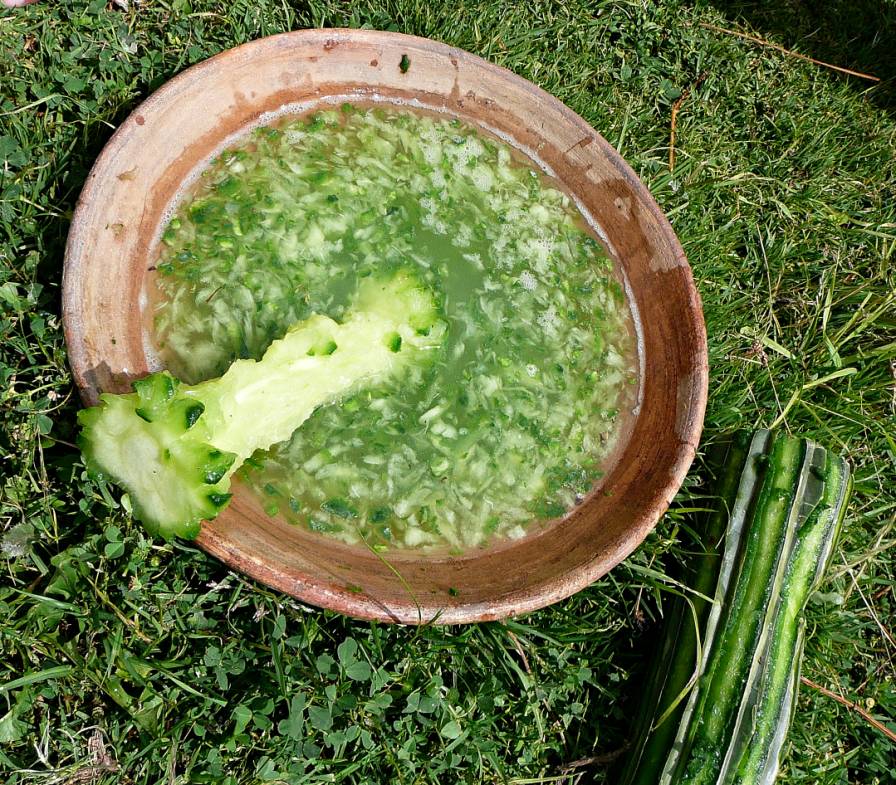
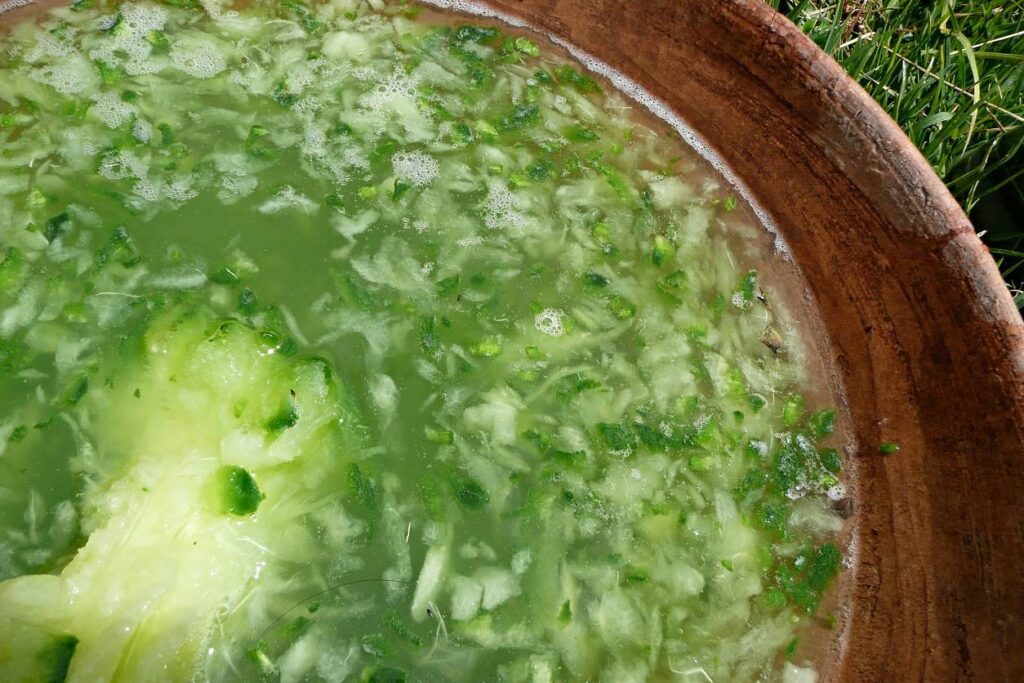 ↑ The completed ‘shampoo’, ready for use ↑
↑ The completed ‘shampoo’, ready for use ↑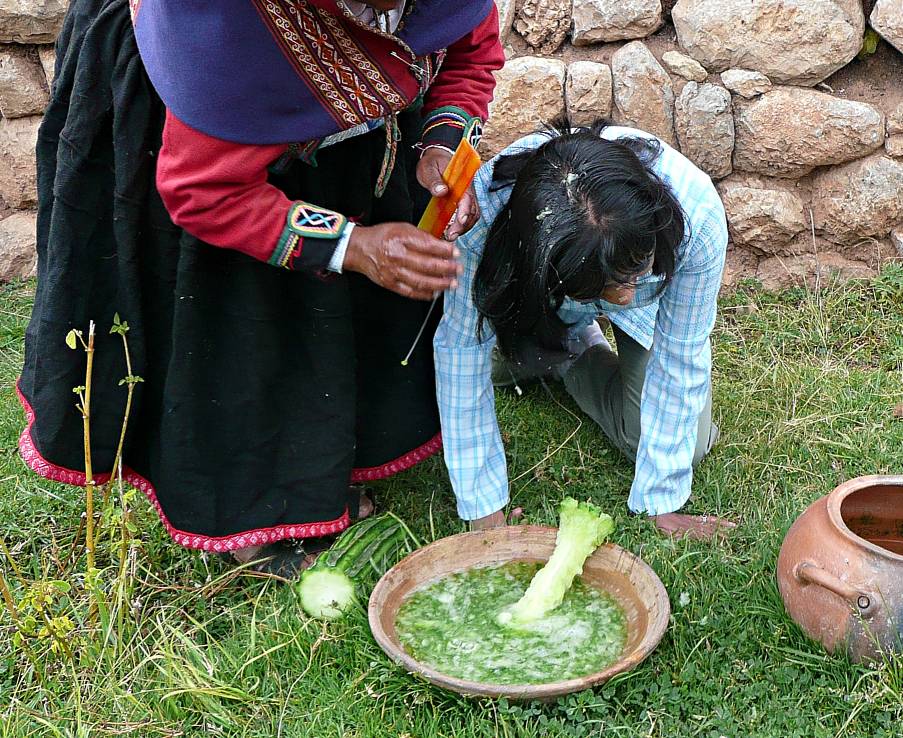

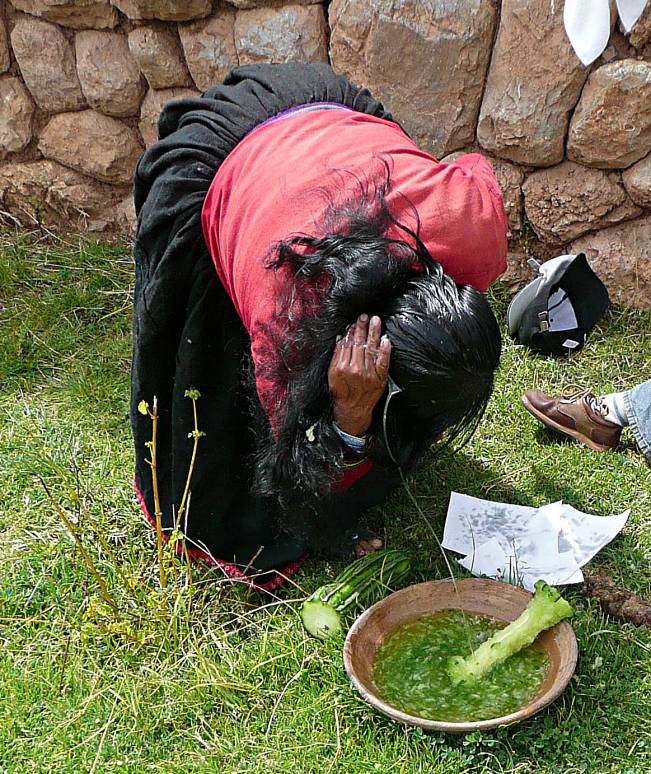 ↑ Rubbing the ‘shampoo’ into the hair; it can be rinsed after 45 minutes or simply left in ↑
↑ Rubbing the ‘shampoo’ into the hair; it can be rinsed after 45 minutes or simply left in ↑
__
Trichocereus cuzcoensis BK08519.4 (=T. peruvianus v. cuzcoensis) “Hawaq’ollay” “San Pedro Agreste”
Upright to sprawling and decumbent columns to 10′. Yellow/gold to gray spines, up to 3″+ long. Many specimens were covered in small Tillandsia, giving the stems a fuzzy appearance. Populations growing near the base of the mountain on which the Incan site occurs, on steep, rocky cliffs overlooking the Urubamba River, a couple miles outside outside the modern town of Pisac, Cusco Dept., Peru, near 10,000′. Occurring with the ‘new’ Echeveria cuscoensis (which we helped describe), Ephedra americana, Peperomia galioides, P. aff. lanuginosa, P. peruviana, Pilea sp. & P. serpyllacea, Oxalis sp., Puya sp., several Tillandsia, Corryocactus erectus, Lobivia sp., Salvia oppositiflora, Calceolaria sp., etc. This is an important ethnomedicinal species, growing wild and widely planted throughout the region, sometimes as a living fence. The stems are made into a highly regarded ‘shampoo’ that is said to “cure baldness” and headaches. Also used for cough, soar throat, and external wound healing, etc. Scant seed was collected and a single small cutting which was deposited with Dr. Pino in Lima, Peru for the Jardin Botanico. Z8b
- What has been distributed: Seed—only 10 seed in 2008 to supporters of our expedition; a cutting was deposited with Dr. Guillermo Pino in 2008 for the Jardin Botanico, Parque de las Leyendas, in Lima, Peru.
__
Trichocereus cuzcoensis BK08526.4 (=T. peruvianus v. cuzcoensis) “Hawaq’ollay” “San Pedro Agreste”
Our rarely offered accession of this beautiful and misunderstood species. The mother was a large upright stand to about 12′ tall, dark green to bluish stems partially clothed in Tillandsia, long spines: yellow to pale gray/white in this clone. Large, sweetly scented, nocturnal white flowers, edible fruit. Growing with Mutisia acuminata, Bomarea sp, Tropaeolum sp., Clematis sp., Dioscorea sp., Lobivia sp., etc., at the ruins of the sprawling Incan city of Raqchi, amongst the hundreds of round qolqas (storage buildings), located on a prominent ridge overlooking a broad valley along the Vilcanota River, Canchis Province, southern Cusco Dept, Peru, near 11,500′. Clear signs of harvesting – considered a “San Pedro” and utilized as medicine since antiquity. Sections of de-spined stems can still be found for sale at the traditional Cusco markets for use as a famous ‘shampoo’ said to protect hair and promote its growth—even reversing baldness. While we have never had the diligence to adequately test this on our own denuded pate, we have observed firsthand its impressive efficacy for alleviating altitude headaches when rubbed into the scalp and forehead. The flesh of the cactus is also reported as a traditional contraceptive and remedy for burns, fevers, swellings, flu, etc. There are reports the flowers are used for “flying”. The sap is utilized as a natural sealant for adobe walls. Easy to grow and hardy. We’ve only distributed a handful of cuttings of this clone. Z8b
- What has been distributed: Cuttings of 1 clone, offered less than a dozen times since 2018.
 ↑ BK08526.4 ↑
↑ BK08526.4 ↑ ↑ T. cuzcoensis ‘shampoo’ & de-spined stem ↑
↑ T. cuzcoensis ‘shampoo’ & de-spined stem ↑
__
Trichocereus lamprochlorus? BK10508.4
__
Trichocereus pachanoi BK08611.4 “Huachuma” “San Pedro”
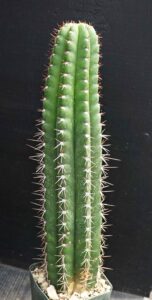
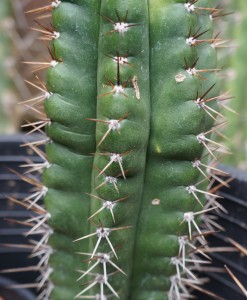 ↑ BK08611.4 clone A ↑
↑ BK08611.4 clone A ↑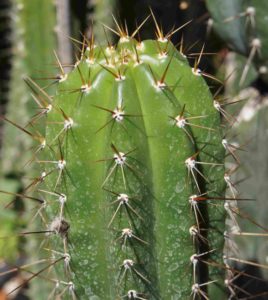
 ↑ BK08611.4 clone B ↑
↑ BK08611.4 clone B ↑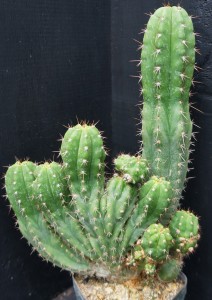
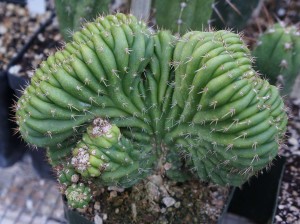 ↑ BK08611.4 mutant clone ↑
↑ BK08611.4 mutant clone ↑
__
Trichocereus pachanoi BK08611.5 “Huachuma” “San Pedro”
__
Trichocereus pachanoi BK14518.4 “Huachuma” “San Pedro”
__
Trichocereus pachanoi f. cristata/monstrosus BK14518.5 “Huachuma” “San Pedro”
__
Trichocereus aff. pachanoi BK10508.1 “Huachuma” “San Pedro”
__
Trichocereus aff. pachanoi BK10508.5 “Huachuma” “San Pedro”
__
Trichocereus aff. pachanoi BK10512.11 “K’ulala” “San Pedro”
__
Trichocereus pasacana/terscheckii BK151012.1 “Pasacana” “Cardon Santos”
Massive tree-like specimen about 20’+ tall. Stems to over 1.5′ thick. Large stout spines. White day blooming flowers, followed by edible fruits known as “Pasacana.” This small population appears to be an intermediate between T. pasacana and T. terscheckii, lower Quebrada del Toro past El Alisal, Salta, Argentina, about 6300′. Z8a/b
More info coming…
- What has been distributed: Seed—a few hundred in 2015–2016; around a dozen seedlings between 2017–2019.
__
Trichocereus pasacana BK151012.2 “Pasacana” “Cardon Santos”
This population was a dense forest of specimens to 25’+ tall. Varied from open spined specimens that had some terscheckii-like properties to the very densely spined classic pasacana appearance. Near Chorrillos, Quebrada del Toro, Salta, Argentina, 7000′. Considered a “holy” cactus. Ashes of the fruits, seeds and flowers are known to be used in special “llipta” mixtures, lime preparations chewed with coca (Erythroxylum species) leaves. Z8a/b
More info coming…
- What has been distributed: Seed—a few hundred in 2015–18; less than a dozen seedlings between 2017–2018.
__
Trichocereus pasacana BK151012.3 “Pasacana” “Cardon Santos”
The most densely spined population we came across during our travels with thick columns to 10–15’+ and even an impressive crested specimen. At the mysterious ancient archaeological site of Santa Rosa de Tastil with its extensive maze of low rock walls, Salta, Argentina, 10,000′. Growing in eroded granite with mounding Ephedra, Larrea, Fabiana and other densely spiny shrubs and cacti. Z8a
More info coming…
- What has been distributed: Seed—several hundred in 2015–2016, around three dozen seedlings between 2017–2023.
__
Trichocereus pasacana BK151014.1 “Pasacana” “Cardon Santos”
Robust large population of this giant to nearly 25′ with a diversity of spination. Near Volcan, Jujuy, Argentina, 7000′. Z8a
More info coming…
- What has been distributed: Seed—a few hundred in 2015–16; about two dozen seedlings between 2017–2023.
__
Trichocereus pasacana BK151014.9 “Pasacana” “Cardon Santos”
Fat specimens to about 20′ bristling with long stout spines, large white blossoms. The sides of many larger plants were clothed in a small Tillandsia species. Our accession of this magnificent giant from near the Incan outpost of Tilcara, Jujuy, Argentina, 8000′. Z8a
More info coming…
- What has been distributed: Seed—several thousand between 2015–2023; several dozen seedlings between 2017–2024.
Trichocereus peruvianus BK08612.4 “Pichu” “San Pedro Macho”
Fat blue-green stems to 6″+ in diameter. New spines red to yellow, to 3″ long. Often growing prostrate or descending. White flowers, sweet fruit. Growing with Peperomia galioides, P. hartwegiana, Mutisia sp., Echeveria backbergii, Agave cordillerensis, Nicotiana glutinosa, Carica candicans, Ephedra americana, Calceolaria sp., Puya aff. roezlii., Anredera sp., Pilea serpyllacea, Matucana sp., Schinus molle, Opuntia sp., etc., as companions. Above the town of Matucana, near 8,600′, Huarochiri, Lima Dept., Peru—classic T. peruvianus from near the type locale. Rarely offered these days. Z9a
More info coming…
- What has been distributed: Seed—many thousands between 2008–2017, a hundred+ seedlings between 2011–2023, a few dozen cuttings from about a dozen different seed grown plants between 2014–2024.
- BK08612.4–A — Seed from specimens with consistently shorter spines, under 1″. Around a thousand seed distributed between 2008–2010. As the seedlings demonstrated the same diversity in spine length as seed from longer spined parents, the seedling distributed were not designated as different.
Trichocereus peruvianus BK08612.9 “Pichu” “San Pedro Macho”
Our 2008 seed collection from plants growing on the arid, steep mountainside by the town of Surco, Huarochiri, Lima Dept., Peru, around 8,000′. Blue, serpent like specimens growing over rocks and down the mountain, alongside Puya sp., Jatropha macrantha, Furcraea occidentalis, Peperomia galioides, Haageocereus, Espostoa, Schinus molle, Anredera sp., Tillandsia sp., Onoseris sp., Lycopersicon pimpineliifolium, Lantana sp., etc. Z9a
More info coming…
- What has been distributed: Seed—a few thousand between 2008–2017; a few dozen seedlings between 2011–2023; cuttings from a half-dozen or more different seed grown plants between 2014–2024.
- BK08612.9 cl. Z
A clone has survived multiple erratic and harsh northern California winters undamaged, suggesting better tolerance of adversity than its siblings. Two cuttings distributed in 2024.
- BK08612.9 cl. Z
Trichocereus peruvianus BK14518.9 “Pichu” “San Pedro Macho”
__
Trichocereus aff. peruvianus f. monstrosus BK151019.1 “Pichu” “San Pedro Macho”
__
Trichocereus riomizquensis BK10508.7 “Achuma”
Upright stands to 8’+ tall. 2–5″ diameter stems with blue-green to yellow-green epidermis. Spines to 3″ long. Planted around the town of Totora, Cochabamba Dept., Bolivia, 9,000′. Local women call it “achuma” and use it externally to treat fever. No one knew where it grew wild. We searched where Ritter first described the plant at Chujllas, and along the Rio Mizque, adjacent valleys and slopes, but never found a single wild plant, only herds of feral goats. Herbarium specimens suggested it still occurred wild, but we did not have time for further search in this remote dry-forest region. The seed grown progeny from this rare accession show great diversity, running the spectrum of plants with short spines of less than 1/4″, to plants with 3″ long spines, and everything in between. Z9a
More info coming…
- What has been distributed: Seed—a couple hundred in 2010; less than a dozen seedlings from 2015–2018; cuttings from about a dozen seed grown plants between 2019–2024.
__
Trichocereus riomizquensis BK10512.1 “Achuma”
Trichocereus riomizquensis BK10512.4 “Achuma”
__
Trichocereus santaensis BK09509.9 “Huachuma” “San Pedro”
Blue-green epidermis. Up to 5 small spines, 1/8–1/4″ long. Stems 3.5–4″ diameter. Large arborescent stand to over 15′ tall. Main woody trunk to 6″+ diameter. Lower stems covered in Tillandsia. Growing with Baccharis latifolia, Ephedra americana, Cyclanthera explodens, Tagetes sp., Agave cordillerensis, Puya sp., Bidens sp., Borzicactus fieldianus, Cylindropuntia sp, etc. Growing on the west side of the Santa River, near Olleros and the ancient pilgrimage road that connects the Callejon de Huaylas with Chavín, 11,000′. This is a poorly understood species that looks to be very similar to the typical “wild” T. pachanoi that occurs in northern Peru and Ecuador. It is possible that T. santaensis should be considered the southernmost range of T. pachanoi. Z9a
More info coming…
- What has been distributed: Seed—several thousand between 2009–2011; a few dozen seedlings between 2012–2016; cuttings from around a dozen different seed grown plants between 2016–2024.
- Clone W: An odd clone with slightly wavy ribs that stood out among the seed grown progeny, a cutting distributed once in 2024.
Trichocereus santaensis BK09509.10 “Huachuma” “San Pedro”
Growing near BK09509.9. Blue-green epidermis. 5 radial spines 0.25–0.75″ long, the downward facing central-radial sometimes up to 1.5″ long. 1 central spine 1.5–2.5″+ long. New spines yellow to brown in color. Stems 3.5–4″ diameter. Stems to over 10′ tall. About 90% of all the Trichocereus growing in this vicinity had very short spines and resembled T. pachanoi. The other 10%, including this collection, had longer spines.
- What has been distributed: Seed—about a thousand between 2009–2011; about a dozen seedlings between 2012–2016; cuttings from one clone [A] between 2014–2022.
__
Trichocereus santaensis BK09511.7 “Huachuma” “San Pedro”
Green to blue-green epidermis, small spines less than 1/8″ to 1/4″ long. Stems to 10′ tall. Originally growing with Schinus molle, Baccharis sp., Cylindropuntia sp., and Bidens sp, just above the floodplains on the west side of the Santa River, at the base of the Cordillera Negra, to the north of Puente Choquechaca, Ancash, Perú, 7250′. Our field bioassay suggests great promise. This beautiful plant has become highly coveted by collectors. Z9a
More info coming…
- What has been distributed: Cuttings of 1 clone offered intermittently since 2014.
Trichocereus terscheckii BK151015.3 “Cardon Santos” “Huachuma Gigante”
Trichocereus totorensis BK10509.19
One of our favorite species. Large plant to 12’+ tall, 10–12″ diameter stems. Many dark green ribs, densely spined with 1″ yellow/orange to white spines. Part of the T. tarijensis complex. Growing with bunch grass, Berberis, Puya aff. humilis, Baccharis, and Aristeguietia. North facing slopes between Inkallajta and Monte Puncu, Cochabamba, Bolivia, near 10,000′. This species appears to be endangered, we only saw small populations growing on rocky cliffs, on the stone walls of the Incan ruins at Inkallajta, and a few scattered mature plants in the remnant Polylepis tomentella ssp. incanoides forest near Totora. Z8a–b
More info coming…
- What has been distributed: Seed—a couple thousand between 2010–2012; approximately two dozen seedlings between 2015–2020.
Trichocereus sp. BK08601.1 “Hawakolla”
Gorgeous arborescent species to to 15’+ tall. Regular branching up high on the thick dark green stems, 6″+ diameter. Strongly notched areoles. Numerous golden to grey spines, up to 2″. White flowers. From a huge patch, occurring almost down to the water, north side Isla del Sol, Lake Titicaca, Bolivia, 12,500’+; growing alongside Puya sp., Siphocampylus sp., Baccharis incarum, Ambrosia arborescens, Plantago sp., Cheilanthes sp., Lobivia sp., Tetraglochin sp., Pernettya prostrata, and Polylepis incarum trees on the way to the most important pukyo in Andean cosmology: the sacred progenitor spring from which the first ancestors emerged… Looks to possibly be planted, we also saw specimens in town and on the ‘mainland’ at the square in Copacabana. Signs of regular harvesting. The Aymara curandero, Lucio Ticona, says it can be used “like achuma”, but is “different” in effect (he also shared that a strong tea of Baccharis incarum produces an “achuma-like effect” and that 20 of the local Lobivia flowers consumed fresh gives “a 15 minute vision of the astral dimension”!). Locals report the flesh is used for toothache. Possibly a new species or subspecies. The plants definitely show some affinity with T. cuzcoensis, yet the spination, ribs, girth and overall habit is very distinct. The plant also looks similar to the cultivated ‘Kimura’s Spiny Giant’ in the US. Coveted by collectors since we first introduced it to the US, we only offer this mysterious beauty occasionally. Z8b?
- What has been distributed: A few dozen cuttings of 1 clone offered intermittently since 2015.
Trichocereus sp. BK08601.2 “Hawakolla”
The same species as BK08601.1; a robust, healthy looking patch with candelabra stems 10–14′ tall, planted by someone’s home, near the back of the small town, north side Isla del Sol, Lake Titicaca, Bolivia, 12,500’+. The Aymara owner of the house said that a slice of stem is held externally against the cheek to soothe the pain of a toothache. He also told us that “Argentinian tourists use it as a drug”. Growing with Colletia spinosissima, Baccharis incarum, Ambrosia arborescens, Plantago sp., and some ornamental shrubs. Z8b?
- What has been distributed: 30 seed in 2008 to supporters of our expedition; there are 2 surviving seed grown plants in our collection, never cut or distributed.
__
Trichocereus sp. BK09508.2 “San Pedro de Chavín”
Large stand to over 12′ tall, individual stems to 3.5–4″ diameter with dark green epidermis. 5–7+ radial spines 0.5–1″ long, the downward facing ones up to 1.5″; one central spine 1.5–2.5″+ long. New spines yellow to red-brown in color. The Trichocereus in this region show a lot of morphological diversity; overall they appear intermediate to T. pachanoi/santaensis and cuzcoensis. Many of the stems of this impressive stand were covered in a couple different Tillandsia species, the larger of which were a striking burgundy color, and a small, epiphytic orchid. Growing with a diversity of companion plants, including Dodonaea viscosa, Kageneckia lanceolata, Satureja elliptica, Alonsoa sp., Berberis sp., Valeriana sp., Browellia multiflora, Tagetes sp., Bomarea rosea, Puya sp., Peperomia galioides, Anredera sp., and nearby—Borzicactus fieldianus, Peperomia aff. naviculaefolia, Sedum aff. reniforme, and Matucana sp. Occuring at 11,050′, at the edge of what looks like ruins or perhaps an old chacra wall; above Tres Cruces, on the western mountain just above the ancient ruins of Chavín, to the north side of the Wachesca River; eastern slopes of the Cordillera Blanca, Ancash Dept., central Peru. The 3000 year old temple complex of Chavín de Huántar is where the oldest depiction of a succulent plant (and possibly of its propagation) occurs—an anthropomorphic being carrying what is thought to be a rooted Trichocereus cutting. Interestingly, in cultivating this clone in northern California, the spines have remained shorter, often no more than 0.75–1.25″. Z9a
- What has been distributed: Around a dozen cuttings from 1 clone, offered intermittently since 2016.
Trichocereus sp. BK09508.7 “San Pedro de Chavín”
Another large candelabra stand with about 2 dozen stems up to 14′ tall, located lower down the trail from BK09508.2, near 10,700′. The spines on this plant weren’t quite as dense, the 5–7 radial often 0.25–0.5″ long, the downward facing sometimes up to 1″; one central spine to 1.5–3″ long. The skin was more blue-green, the ribs slightly more rounded, and the stems consistently a bit thicker (some to over 4″ diameter), making this plant more peruvianoid in appearance than the other specimens we observed in the region. The community of plants it was growing with included Citharexylum sp., Tecoma sp., Kageneckia lanceolata, Commelina fasiculata, Valeriana sp., Tagetes sp., Pseudonoseris glandulosa, Ipomoea sp., Pilea sp., Portulaca sp., Cheilanthes sp., Puya sp., Peperomia galioides, a few Tillandsia on the stems, and a large patch of Agave cordillerensis nearby. The seed grown plants from this accession have so far shown the diversity in form typical to the region. Z9a
- What has been distributed: 20 seed in 2009 to supporters of our expedition; there are 5 surviving seed grown plants in our collection, never cut or distributed.
__
Trichocereus sp. BK09509.1 “San Pedro de Chavín”
The mother was a candelabra stand to about 9′ tall, with relatively slender, dark green, blue-blushed branches to about 3″ diameter. 5–7 radial spines, the downward facing ones up to 1″ long. 1 central spine 1–2″+. Interestingly, the gross morphology of this specific plant reminded us somewhat of Trichocereus bridgesii, causing us to wonder at the morphological diversity among the Trichocereus at Chavín. Growing on a collapsed rock wall with Agave cordillerensis, next to a field of fava beans and Eucalyptus trees, past the north end of the town of Chavín, 10,500′, Ancash Dept., Peru. Z9a
- What has been distributed: Seed—around a thousand between 2009–2010; a dozen seedlings between 2012–2014; cuttings from several seed grown plants offered intermittently since 2015.
Trichocereus sp. BK09509.2 “San Pedro de Chavín”
Candelabra stems to 10’ tall and 3–4″ diameter; dark green epidermis, new growth blushed blue. 5–7 radial spines, the downward facing ones up to 1.5″ long. 1 central spine to 2.5″. New spines yellow to red-brown in color. Looks intermediate to T. pachanoi/santaensis and cuzcoensis. Growing on rocky cliffs with myriad interesting companions plants, such as Oxalis sp., Peperomia galioides, Peperomia aff. andina, Opuntia sp., Commelina fasiculata, Dodonaea viscosa, Sedum aff. reniforme, Salvia oppositiflora, Pseudonoseris glandulosa, Tagetes sp., Cheilanthes sp., Krameria sp., Asphodelus sp., Ipomoea sp., Bomarea rosea; western slopes above the north end of the modern town and ancient ruins of Chavín de Huántar, 10,600′; eastern slopes of the Cordillera Blanca, Ancash Dept., Peru. Z9a
- What has been distributed: Seed—around ten thousand between 2009–17, several dozen seedlings between 2012–2020, cuttings from around a dozen seed grown plants offered intermittently since 2018.
Trichocereus sp. BK14515.17
Upright columnar green stems to 8’+ tall and 2.5–3.5″ diameter. 7–8 ribs, 1/2–2″ long golden spines that age gray. New growth is almost tubercled. Steep rocky cliffs on the trail to Choquequirao, edge of cloudforest near Sunchupata, 9600′, Cusco Dept., Perú. We were originally unsure if this was a Trichocereus or a Corryocactus, as Trichocereus was otherwise absent from this region while there were numerous Corrycocactus species. In 2024 it produced its first flower—a large, funnel-form white blossom, confirming it is indeed a Trichocereus. It appears to have some affinity with T. cuzcoensis yet is distinct, perhaps a new subspecies. It is very possible its presence here is an anthropogenic relic from Incan times. Z9a?
More info coming…
- What has been distributed: Cuttings of 1 clone, only offered twice via auction in 2018 & 2019.
Trichocereus sp. BK14515.23
Appears to be the same species as BK14515.17, spines slightly shorter on this clone. Looks to have been planted, the small ‘village’ of Caserio Santa Rosa, nestled amongst dry forest above the Apurimac, 6800′, Peru. Z9a?
More info coming…
- What has been distributed: Cutting of 1 clone, only offered once via auction in 2018.
__
Trichocereus sp. nova? BK151013.5
Likely a new species as this uniquely beautiful plant does not fit any published description we could find. Upright, dark green stems to 7’+ tall and 3–4.5″+ diameter. 9–11 ribs, white felty areoles and 1/4 to 1/3″ spines, yellowish aging white. Large, sweetly scented, funnelform white flowers; 2–3″ fruit, juicy sweet. Looks similar to some of the Trichocereus–Echinopsis hybrids. A unique plant that we discovered in 2015 growing on exposed, steep rocky embankments in Yungas cloudforest, Calilegua, Jujuy, Argentina, near 4500′. Growing among shrubs with Puya sp., Peperomia aff. galioides, and a Begonia species, near Anadenanthera colubrina trees. Easy to grow, cold hardiness is still untested. Z9a/b?
More info coming…
- What has been distributed: Cuttings from 3 clones—A,B,C, about a half dozen of each clone between 2019–2024; 5 seedlings since 2022; about 150 seed since 2023 (distributed seed & seedlings nursery produced under controlled pollination of the 3 clones).
♦
This page is informational, for Trichocereus available to order, see our Specimen Plant List
__
♦
About the genus Trichocereus
Large genus of some 50–80+ species native to the Andes of Ecuador, Peru, Bolivia, Argentina and Chile. Decades ago Trichocereus was merged with the closely related genus Echinopsis, then recently segregated again to Trichocereus but with questionable changes, leading to great confusion. In many ways this genus is a perfect case study in the absurd modern trends in armchair taxonomy. Here we recognize Trichocereus as a distinct genus, variable in size and form; sometimes low growing multi-branching colonies, others large candelabra-like stands(the “San Pedros”), to imposing tree-like giants. All produce large funnel shaped flowers that are often sweetly scented. These magnificent flowers are either white and nocturnal or multi-colored and diurnal. The fruits are edible and quite delicious. Often mistakenly thought of as sun-baked desert plants, many of these species are in fact integral members of forest ecosystems –– from Prosopis and Anadenanthera dry forests to Polylepis cloudforests. The oldest depiction of a succulent plant (and possibly of its propagation) is an anthropomorphic being carrying what is assumed to be a rooted Trichocereus cutting at the 3000 year old temple of Chavín de Huantar in the central Peruvian Andes. Today cuttings are often planted as living fences throughout South America. Flower petals and the inner flesh of most species are excellent external remedies for wounds and burns much like Aloe vera. A medley of species, known locally as “San Pedro”, “Huachuma” in Quechua, or “Achuma” in Aymara, are central to the Curanderismo healing traditions of the Andes. Cut stems of some species are traditionally used to “purify” water and in some regions made into an esteemed shampoo. All are relatively fast growing, very easy care for, and fairly cold & wet tolerant. For the best growth provide a rich, well-drained soil, plenty of horizontal root room, bright light, regular water and balanced nutrients during spring and summer. Trichocereus provide some of the best long lived grafting stocks. We began hybridizing Trichocereus in 1996 and have introduced hundreds of unique crosses over the years. Increasingly popular as drought hardy landscape specimens, there has been a surge of interest in the horticultural merit of Trichocereus. In fact, in what we have come to think of as Trichomania, the number of collectors has skyrocketed in past decade from a couple hundred worldwide to many thousands!
Note: For optimal haleness and resilience, we grow our Trichocereus “hard”, it is not unusual for the cuttings we offer to have a bit of a weathered look, similar to plants in habitat, as many come from our mother plants grown outside year round, exposed to the full barrage of northern California elements — winter months of heavy rain, regular frost in the mid to low 20°s F (& usually 1-2 weeks in the high to mid teens), then the hot summer sun and recurring dry periods. The seedlings and plants in the greenhouse are grown in bright filtered light, are given seasonal dry cycles, and exposed to cold in the high to mid 30°s F during winter. We feed all of our Trichocereus enough organic food to support vigor, but we do not push them for maximum growth — heavy fertilizing may produce fast growth with an alluring “unblemished” look, but 30 years of experience has demonstrated that such plants tend to be notably less sturdy and more prone to pests & problems. Our goal has always been to offer the hardiest plants possible.
Trichocereus Companions:
In habitat, Trichocereus occur with a diverse array of companion plants and we encourage you to try growing them with some of their commonly associated Andean species: in grouped plantings, in pots side by side, or even in the same pots—many associates are low growing or groundcovers that can be planted around the base of the columns. Consider your climate, growing environment and how the following plant allies may complement your Trichocereus specimens: cacti such as Borzicactus spp., Cleistocactus spp., Corryocactus spp., Armatocereus spp., Lobivia spp., etc.; small succulents such as Peperomia galioides & other aromatic Peperomia spp., Echeveria & Sedum spp., Pilea spp., shrubby Ephedra spp., to larger succulent companions like Agave cordillerensis & Furcraea spp., floriferous Puya & other terrestrial bromeliads (Abromeitiella, Deuterocohnia, etc.), or caudiciform papaya like Carica & Jacaratia; the xerophytic Barbaceniopsis vargesii; flowering bulbs—Cypella, Eustephia, Stenomesson, etc.; ferns like Blechnum, Cheilanthes & Pellaea spp.; climbers such as Bomarea spp., Ipomoea & Dioscorea spp., Passiflora spp., Mutisia acuminata, etc.; low shrubs like the xerophytic perennial tobacco Nicotiana benavidesii & other Nicotiana spp., Siphocampylus tupaeformis, Baccharis spp., Calceolaria spp., Begonia spp., the furry leafed Lessingianthus asteroflorus, Salvia spp., fruiting Lycium, Myrteola & Ugni spp., Pernettya & Vaccinium & other neotropical blueberries (Disterigma, Cavendishia, Ceratostema, Macleania, Satyria, etc.),; tall shrubs & trees like Colletia ulicina, Luma spp., Buddleja spp., Aristotelia chilensis, Sambucus peruviana, Anadenanthera colubrina, Polylepis & Escallonia spp., Alnus & Podocarpus spp., Geoffroa & Zizyphus; etc. Or use your imagination and choose plants from other regions of the world to fit a similar companion niche! (Check throughout the Specimen Plant List for such plants).
♥
Page Under Construction… check back for updates